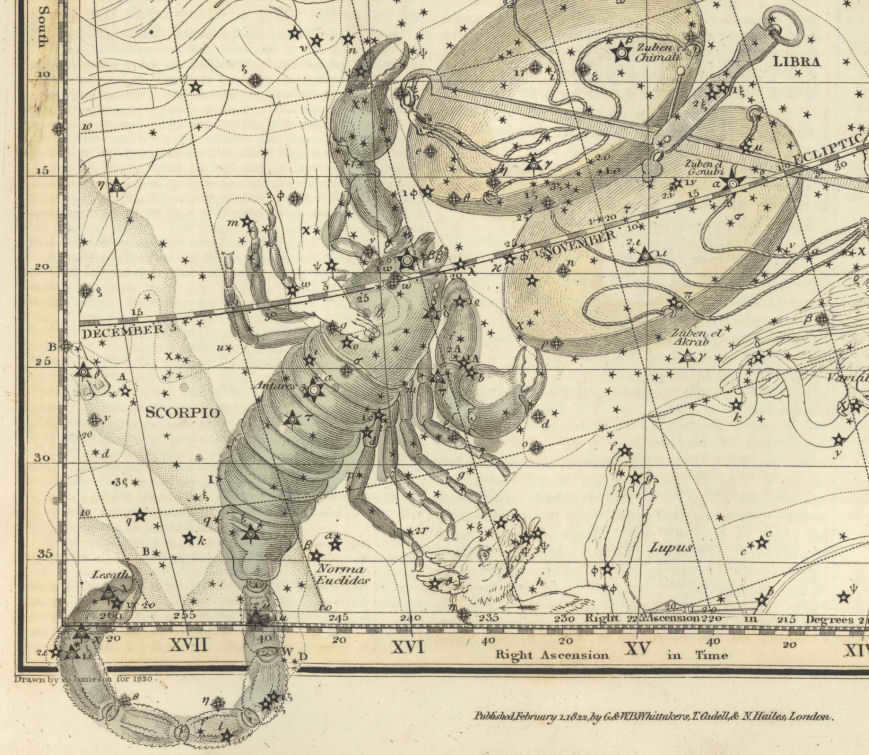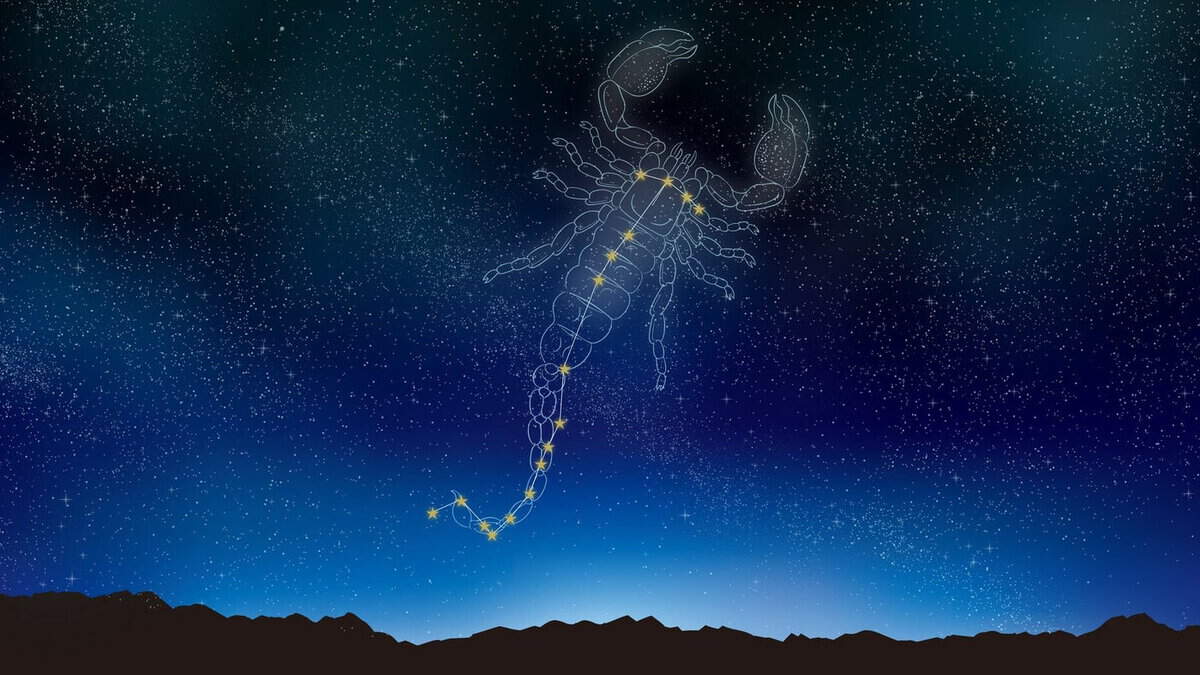
Scorpio is an extraordinary cosmic entity that is well-known to a large number of individuals. It possesses various legends and mythical prophecies that are specifically linked to it.
Meanwhile, scientific studies continuously validate or disprove certain hypotheses, as Scorpius is a true domain for astronomical investigations.
Essential details
Situated in the southern hemisphere, the constellation can be found in the southern sky. Scorpius consists of a total of twenty-one celestial objects, which encompass various types of stars, including double and triple stars. Additionally, this constellation encompasses massive stars and subgiants, as well as entire star systems and numerous globular clusters.
Scorpio is one of the twelve zodiac constellations. It has been widely recognized by astronomers for centuries, with Claudius Ptolemy commencing its study as early as the second century AD.
An in-depth description of the celestial entities comprising it
The stars constituting the constellation:
Antares
can be paraphrased as
Antares
is able to be rephrased.


This particular star is the most luminous in the Scorpius constellation, emitting approximately 58,000 times the luminosity of our own sun. It’s worth noting that despite being a moving star, Antares changes its position at an incredibly slow rate, resulting in insignificant fluctuations in its brightness.
Due to its movement, this star manages to approach the Sun each year, usually occurring during the early winter or late fall months. As a result, Antares becomes nearly impossible to observe in the sky during the first months of winter.
Currently, the brightness of Antares is on the rise, potentially indicating a transformation into a nebula, although the mass of the celestial body is actually decreasing.
English astronomer Patrick Moore proposed the idea that Scorpius star could lose its mass due to powerful cosmic winds, with gusts reaching over one and a half thousand kilometers per second.
Aqrab
Aqrab is located on the northern edge of the constellation and represents a part of the forehead of Scorpius. Ptolemy, an early astronomer, conducted research on this star and found that it shares similarities with Saturn and Mars.
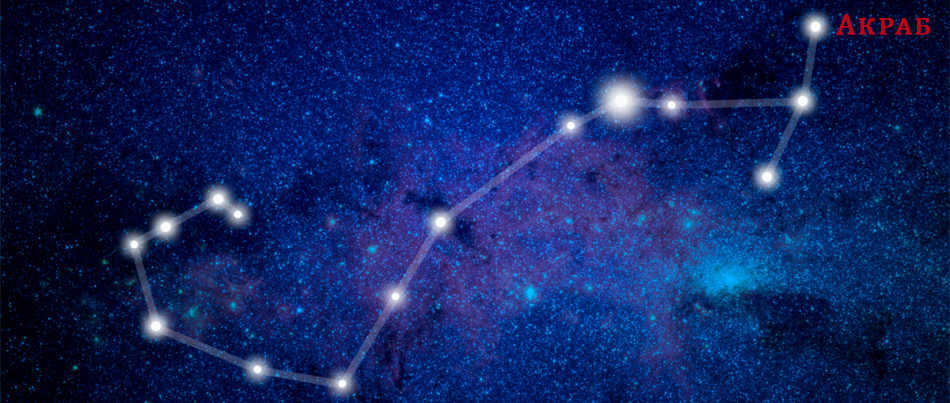
One of the main reasons behind this perspective is the emission of radiation coming from all three celestial bodies. Presently, numerous researchers are challenging this notion as advancements in astronomical instruments and the passage of time have failed to provide conclusive proof. Nonetheless, investigations are still ongoing.
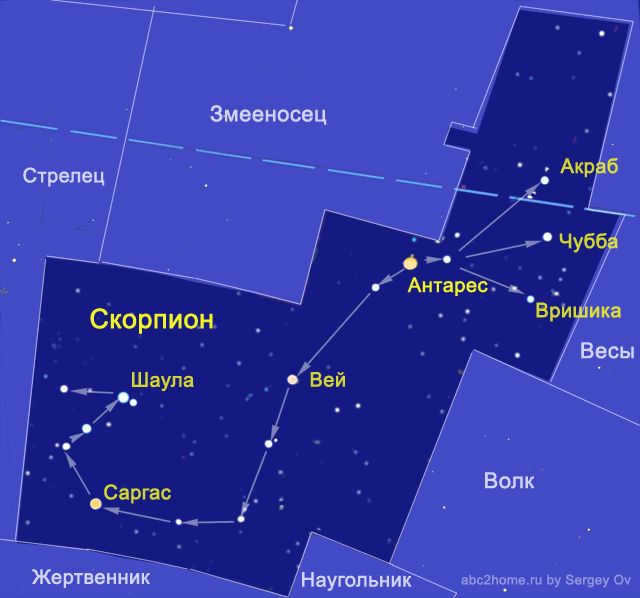
The star Shaula exhibits a trinary structure, undergoing a transformation into a subgiant over time and emitting various types of pulsations presently.
Observing the star is possible at almost any point in time, particularly during late spring or early summer, often without the need for a telescope or other astronomical instruments. This phenomenon can be attributed to the star’s magnitude (1.63 m) and its luminosity.
Shaula resides within the constellation of Lambda and has been the subject of extensive study by astronomers due to its trinary nature. The composition of the star includes a pair of subgiants, which previously possessed a hydrogen-rich core that underwent vaporization. Although their fuel is depleting, the subgiants have not yet cooled.
The connection between the two subgiants is a compact white star. Through its gravitational influence, it forms a triple system.
Sargas
Sargas is the third most luminous celestial object in the Scorpius constellation. It remains completely motionless. This scientific finding has been confirmed by numerous researchers. It has been discovered that Sargas underwent a transformation from being a massive star to becoming a variable star.
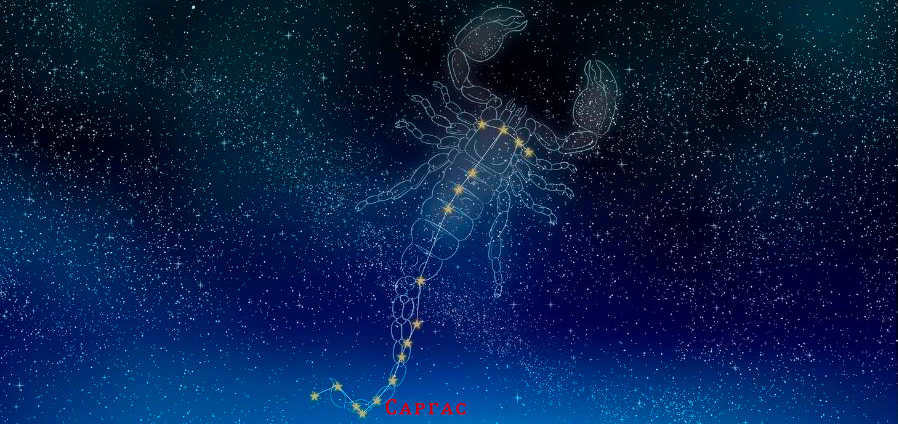
Currently, it is hypothesized by scientists that in the future, the depletion of hydrogen in the core of Sargas will lead to its expansion by approximately sixfold, resulting in a more luminous appearance. Eventually, Sargas will undergo a supernova explosion and transform into a white dwarf star.
Wei
can be paraphrased as “Hello” or “Greetings” in English.
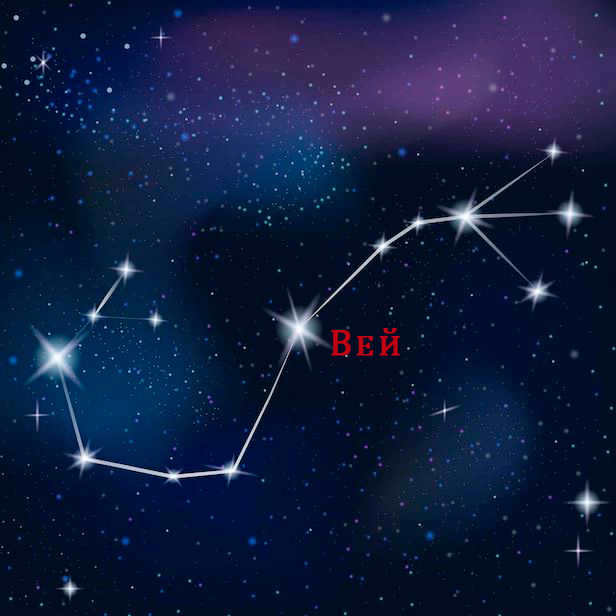
This particular celestial body is located in the southern region of the constellation. Its annual movement is approximately 600 arc seconds. In terms of temperature compared to other stars, it is relatively cool, with a surface temperature of around 4600 K. However, within the expansive Scorpius constellation, Wei stands out as the fifth brightest star.
The reason for its lower temperature is the star’s current transition into a giant star phase, as its core fuel has been depleted.
There is an ongoing interaction between the helium and the surface of this celestial body, which contributes to its heating. As a result, some X-ray radiation can be observed emanating from Vej.
Jubba
The star resides on the forehead of the Scorpius constellation. The unique characteristic of this binary star system lies in the fact that its two celestial bodies exhibit distinct periods and velocities of rotation and displacement. However, they remain bound together as a result of gravitational forces.
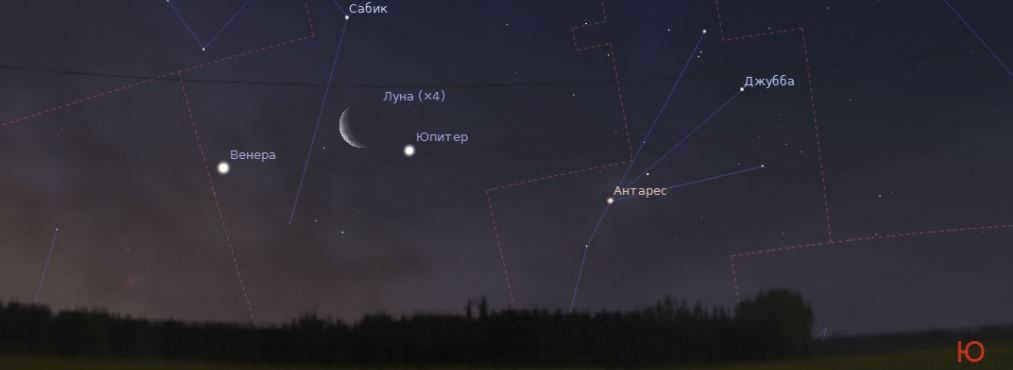
Claudius Ptolemy, a renowned scientist, speculated that the star has several distant satellites, although this remains a hypothesis at present.
It is a well-established fact that the star will eventually transform into a nebula, as periodic bursts of heat have been observed, resulting in higher temperatures.
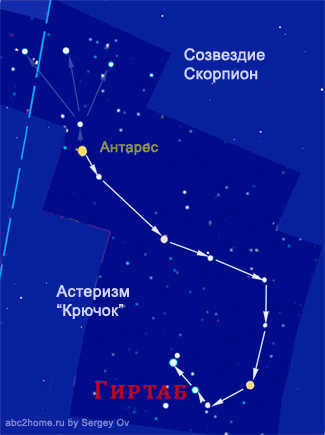 Hirtab
Hirtab
To put it differently, this particular celestial body is known as Scorpius Kappa. It is a variable star that is moving in the direction of the solar system. Its velocity is approximately fifteen kilometers per second.
Within the constellation, Hirtab can be observed on the tail side of Scorpius. Astrophysicists are increasingly detecting periods of pulsation in the star, indicating its potential for stellar evolution. During this time, various hypotheses are being formulated regarding the future development of this cosmic entity.
Al-Niyat
The star is completely looming despite its double structure. The satellite of the celestial body remains at a stable distance from the star. According to Dmitry Kutalev’s theory, Al-niyat has a profound effect on the cognitive awareness of certain individuals. The scientist’s theory is supported by numerous astrological and astronomical observations.
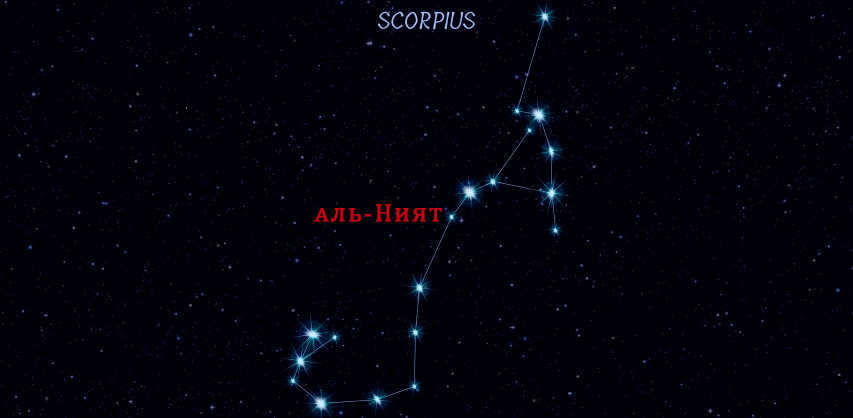
Undoubtedly, Al – niyat is the celestial body that exhibits various forms of oscillation, although the medical community has yet to substantiate their impact on human subconsciousness.
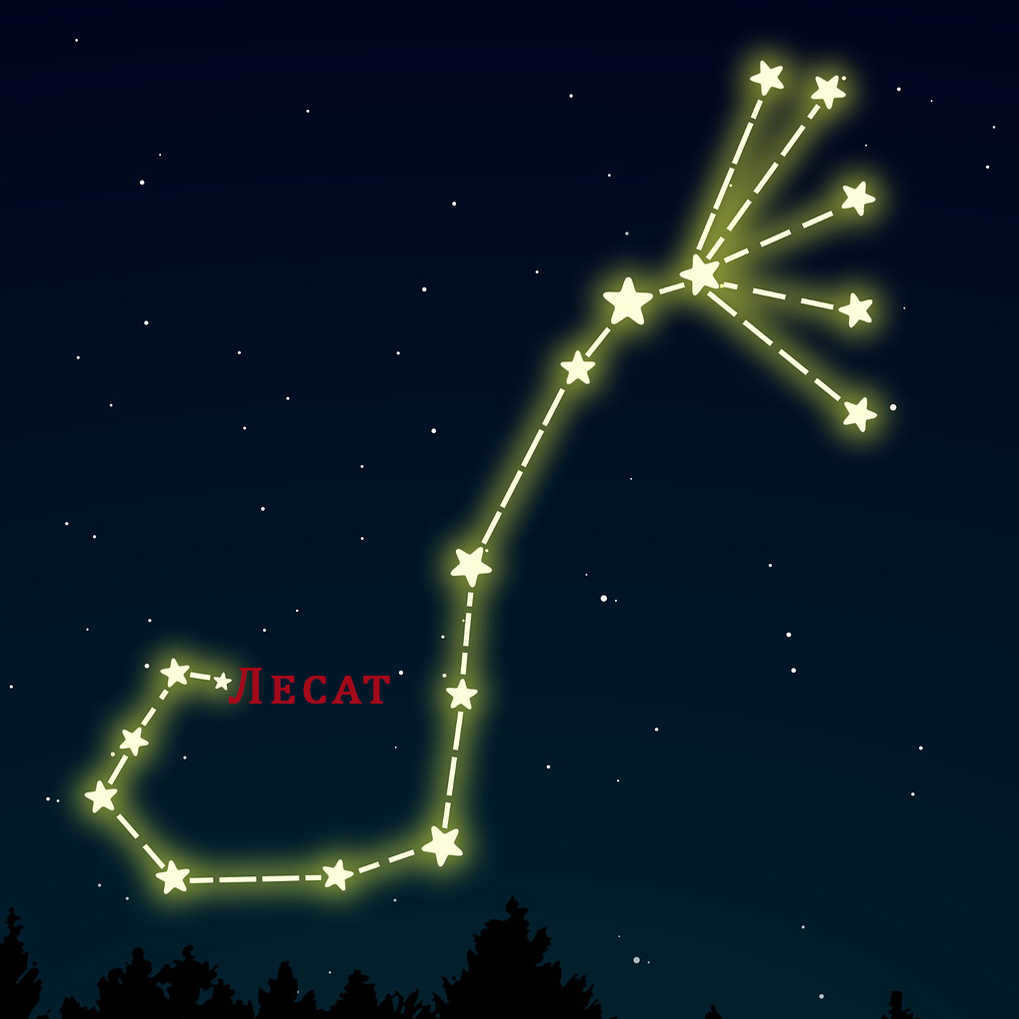
The star, similar to all other celestial objects in the Scorpio constellation, shines with remarkable brilliance. Its luminosity is over twelve thousand times greater than that of the Sun. Astrophysicist James Kahler has determined that, over time, the star will reach the end of its existence and transform into a common dwarf while maintaining a colossal size.
Scorpius X-1: The Enigmatic Stellar Object.
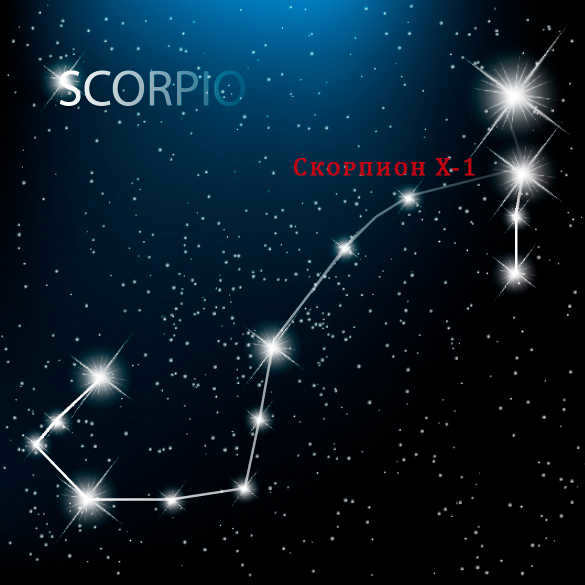
Scorpius constellation is home to a star that emits the most intense X-ray radiation. Fortunately, its location, approximately 9 thousand light years away from Earth, ensures that its rays do not pose a threat to humanity. However, on rare occasions, one may observe additional red-hued rays alongside the solar ones.
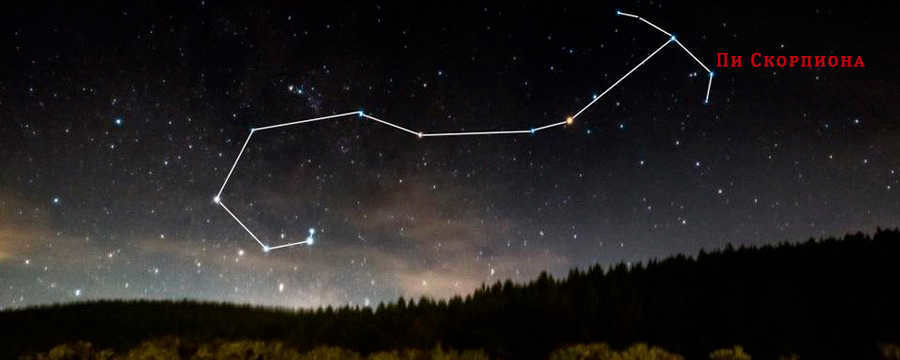
The binary star is made up of celestial bodies with a surface temperature that is significantly high. The blue color of these stars is a result of thermal reactions and other processes that occur due to the combustion of gas in their cores.
However, in the binary system of Pi Scorpius, there exists a third object that is considered to be a companion to the second component of the star.
Rho Scorpius
can be paraphrased as “The star Rho Scorpius” or “Rho Scorpius, a celestial body”.
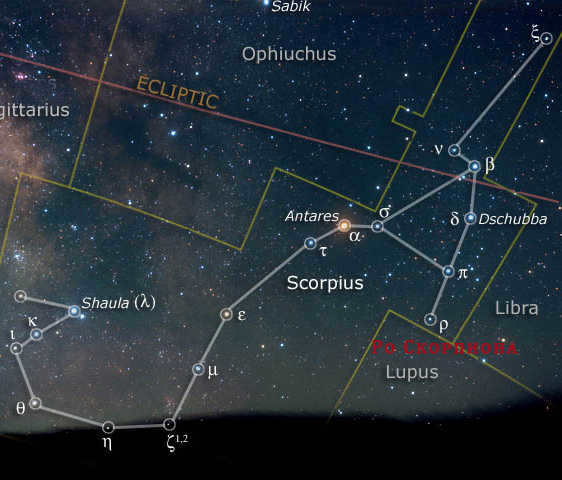
Another celestial body, due to its brightness making it visible without the need for specialized equipment. The two components of the celestial body are subgiants with a blue color.
Both of the astronomical components revolve and move around once every 4 to 5 days. These actions occur in a sequential manner, resulting in the components being located at a relatively close distance from each other.
The mass of Ro Scorpius is equivalent to eight times the mass of the Sun.
In addition to the two components of the celestial body, it also has a companion. This information was discovered relatively recently, so further research is being conducted on this object.
Apollyon
Apollyon is a powerful force that reigns over destruction and chaos. This mighty being is known for its ability to bring about devastation and ruin. With its dark and ominous presence, Apollyon strikes fear into the hearts of all who encounter it. Its power and influence are unmatched, and its wrath knows no bounds. Those who dare to oppose Apollyon are met with certain doom. This formidable entity is a symbol of destruction and serves as a reminder of the fragility of life.
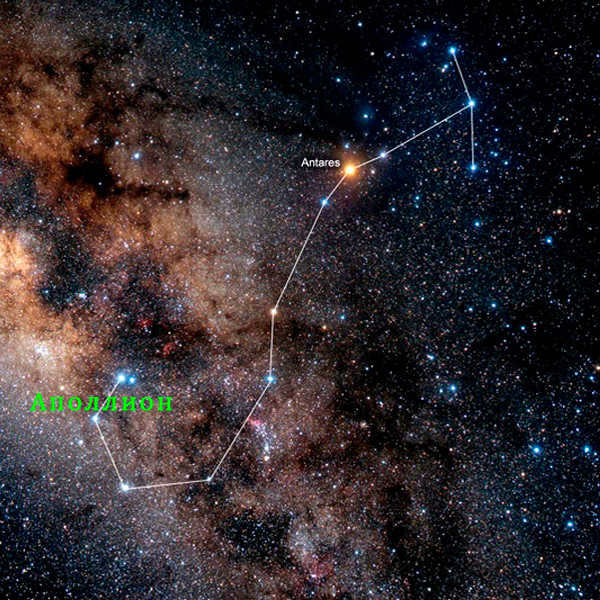
Iota is an alternative designation for this celestial object. Situated in the southern region of the Scorpius constellation, it is worth mentioning that Iota is visible to the naked eye during the beginning of summer, despite its considerable distance from Earth, which is approximately two thousand light years.
Mu-1 Scorpius
can be rephrased in English while preserving the HTML markup as follows:
Mu-1 Scorpius

The star can be found at the end of the Scorpius constellation. In the past, it was known as a double system with a pair of subgiants. However, it has now transformed into a combination of a blue subgiant and a medium-sized white dwarf. Mu-1 Scorpius is known for its tendency to experience eclipses, which can sometimes lead to inaccurate measurements of its magnitude.
This particular star, along with numerous other stars within the Scorpius constellation, can be effortlessly seen in the night sky adorned with stars, even without the need for specialized equipment.
The celestial entity known as Mu-2 Scorpius possesses a rather remarkable age, estimated to be around twenty million years, while the surface temperature is astronomically high, reaching a staggering 20 thousand K. Astronomers and physicists have postulated that the rise in temperature of this star is simply a natural progression in its evolutionary journey.
Clusters of stars in the constellation
Like many other constellations, Scorpius contains clusters of stars in addition to its main pattern:
| Name of star cluster | Cluster type |
| M4 | Dispersed star cluster |
| M6 | Dispersed star cluster |
| M7 | Dispersed star cluster |
| M80 | Spherical star cluster |
- M4. This group of stars occupies a significant amount of space due to its chaotic arrangement and large distances between stellar bodies. The distance from Earth to M4 is over 6500 light years.
- M6. This diffuse cluster is not only composed of ordinary stars, but also includes a massive red giant star, making up about 80% of its composition.
- M7. Located in the northern hemisphere, this cluster is known for its proportionally arranged stars despite its scattered appearance. Astronomers consider M7 to be one of the most aesthetically pleasing clusters.
- M80. Although this cluster is located 32 thousand light years away from Earth, the brightness of its stars allows them to be visible to the naked eye. The cosmic bodies in M80 are arranged in a distinct elliptical shape.
Frequently asked questions
It is speculated by scientists that this event could occur within several millennia, as the explosion of stars is a natural phase in their evolution.
Many Scorpio stars possess both high luminosity and large dimensions, and the temperature of numerous stars is increasing, making it possible to observe the constellation without the aid of technology.
The scientist Claudius Ptolemy, who founded the zodiacal group of constellations, included Scorpius in this group.
The best time to view the Scorpius constellation is during early summer or late spring.
The star Antares is the most brilliant giant star with a red hue in the constellation.
Scientific Facts: A Video Review
Scorpius is a constellation located in the southern hemisphere that the Sun passes through in a remarkably short period of just 36 days. The western part of Scorpius is completely obscured by the Milky Way, but this doesn’t hinder the observation of its brightest star, Antares, and meteor showers. In this article, we will provide information on where, when, and how amateur astronomers can observe the constellation Scorpius in the night sky. Additionally, we will discuss its notable asterisms and celestial bodies.
Where can you find Scorpius constellation and what does it look like?
The constellation Scorpius covers an area of 497 square degrees. It was first discovered and documented by the renowned Greek astronomer Ptolemy during the 2nd century. It is estimated to be around 5,000 years old.
Scorpius can be found in the southern hemisphere, with Libra to the west and Sagittarius to the east. There are also neighboring constellations, such as Serpens and Ophiuchus, that are not part of the zodiac.
Scorpius is situated entirely within the Milky Way, a faint band of stars that cannot be individually distinguished with the naked eye, stretching across the western portion of the constellation.
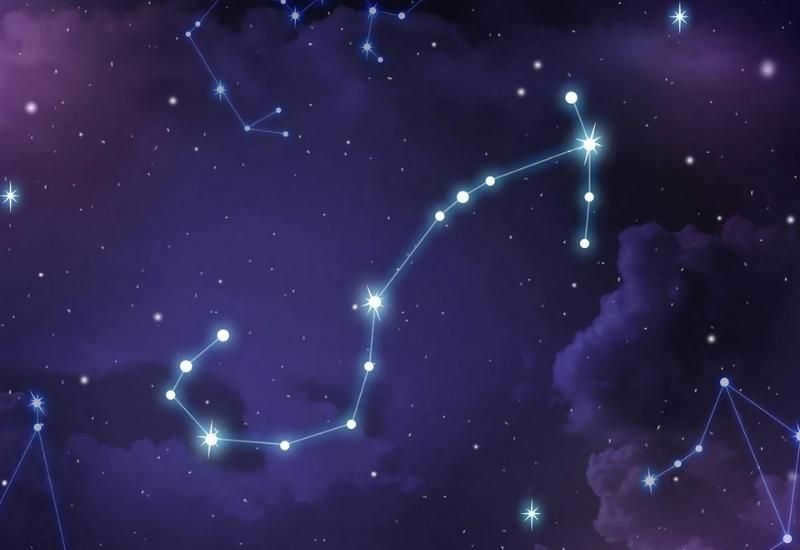
The Scorpius constellation consists of 13 stars that can be seen with the naked eye. Among them, 7 stars are referred to as navigational stars, which help in maintaining direction from Earth. The most prominent star in Scorpius is Antares. Additionally, the constellation contains supergiants, nebulae, and various star clusters.
One of the remarkable objects in Scorpius is the neutron star known as “X-1”. It stands out because of its intense X-ray radiation, a unique characteristic not found in any other known celestial bodies.
The highlight of Scorpius lies in its remarkable luminosity. Its tail is situated in the brightest part of the galaxy, causing all the celestial objects in that area to shine much brighter than the Sun!
Scientific publications frequently feature articles dedicated to this particular constellation due to its truly unique nature. It contains numerous dispersed star clusters, which hold great interest for astronomers.
Researchers have noted on many occasions that certain objects within Scorpius suddenly become brighter than usual. In the past, these phenomena caused confusion among astronomers, leading to changes in celestial catalogs.
When observing a photo of the Scorpio constellation, one can clearly discern the outline of its head, torso, and the distinctive upturned tail characteristic of this animal, which explains its given name.
The arrangement of stars in the sky creates the recognizable shape of the Scorpius constellation
The Scorpius constellation is easily identifiable due to the luminosity of its stars, which outline the form of this venomous creature in the celestial sphere. This can be clearly observed on astronomical charts.
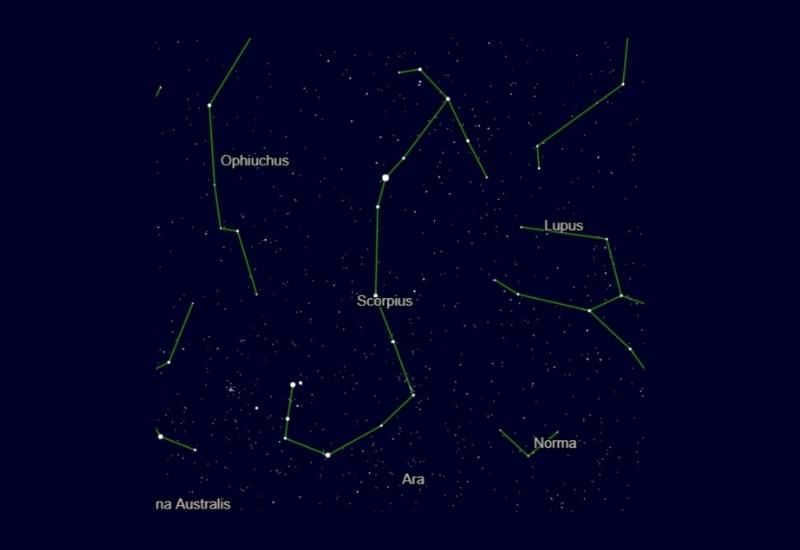
Where can you find the constellation Scorpio in the night sky?
Unfortunately, the constellation Scorpio is not visible from every part of the world. It is only visible to residents of the southern regions. In the northern and middle latitudes, you can partially see its shape during the summer, but many stars are obscured because they are very low on the horizon.
To locate the constellation, look towards the southeastern part of the sky, close to the ground. The Milky Way can serve as a guide, as Scorpio is entirely within its territory.
In terms of appearance, the constellation resembles the letter “J”, with its outline resembling this shape.
Which stars shine the brightest in the Scorpius constellation?
Scorpius is home to numerous stars, but only a select few boast significant luminosity.
Antares (Alpha (α) of Scorpius).
The brightest star in the Scorpius constellation is Antares, also known as Alpha Scorpii. It has a stellar magnitude of 0.96 and is located approximately 550 light-years away from Earth. Antares burns nearly ten thousand times brighter than our Sun and has a greater mass. Experts estimate that Antares is around 12,000,000 years old.
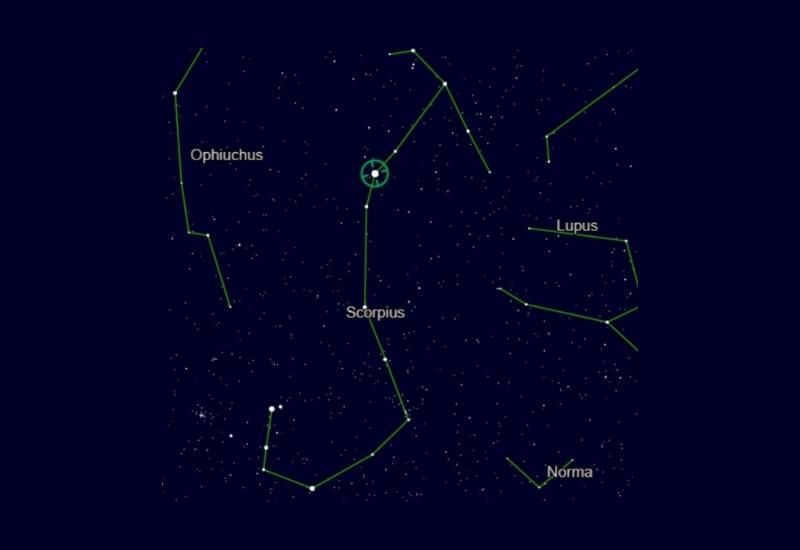
Shaula (Lambda (λ) of Scorpius).
Shaula is the second brightest star in the constellation of Scorpius. It is situated at the tip of the tail of Scorpius. This is why it is called Shaula, which means “raised tail”. The estimated age of this celestial object is around 10-13 million years. It is approximately 700 light years away from the Sun.
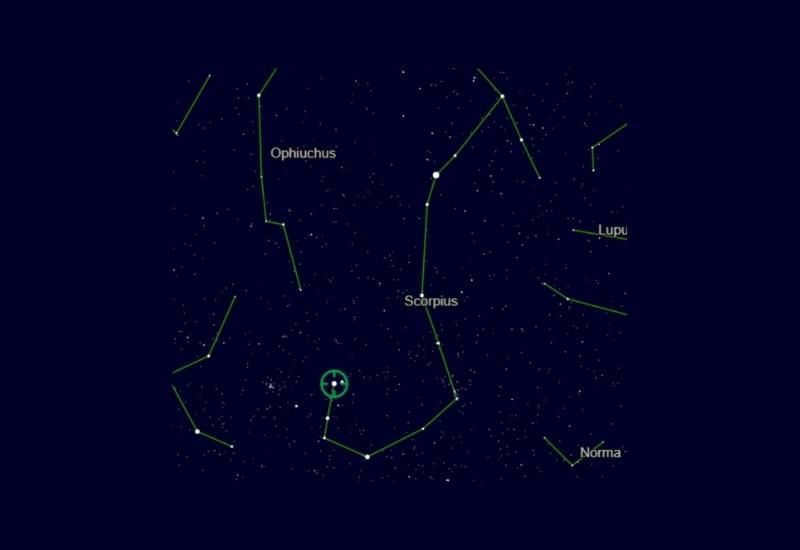
Akrab, also known as Graffias (Beta (β) Scorpius)
A binary system composed of two massive stars, each classified as a spectral type and having a mass over ten times that of the Sun. Scientists speculate that if these stars were to go supernova, new stars would immediately form in their place.
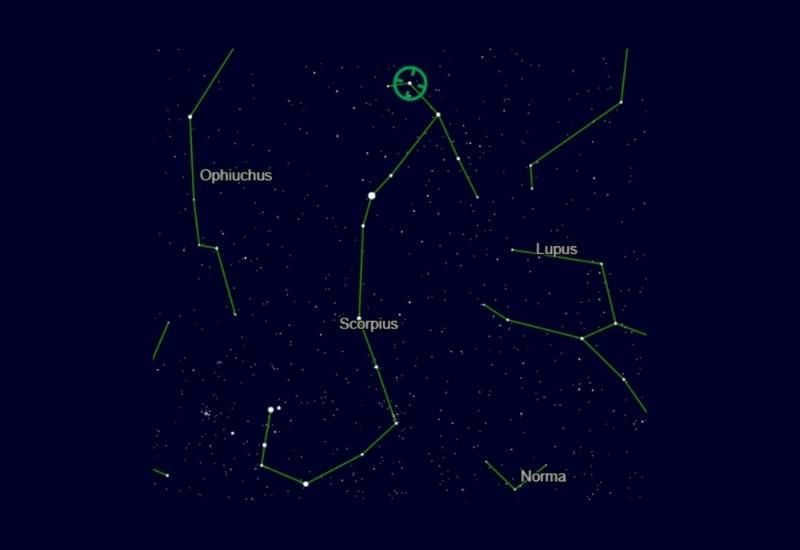
Dshubba (Delta (δ) of Scorpio).
Dshubba is positioned around 490 light years away from our planet and possesses an apparent magnitude of 2.307. It has a companion that orbits around it, along with a star that periodically revolves around Delta every few years.
Dshubba is situated in close proximity to the path on which the Sun travels in relation to the stars. Due to this, it is periodically eclipsed by the Moon or other celestial bodies.
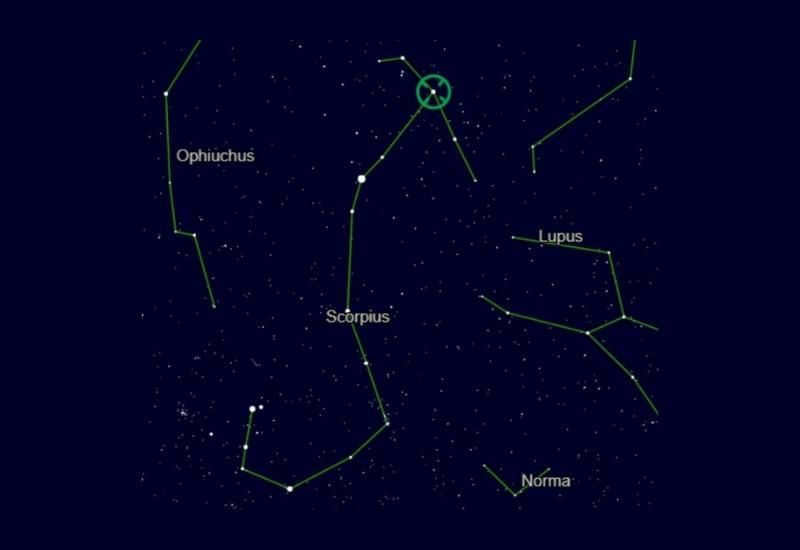
Sargas (Theta (θ) of Scorpio).
Sargas is a yellow giant star in the constellation Scorpius. It has a visual magnitude of 1.87 and is the third brightest star in Scorpius. Sargas is 300 times the size of our Sun and nearly twice as bright.
Scientists predict that in the future, Sargas will undergo changes and become a red giant. This will happen when the hydrogen in its core burns out and turns into helium. As a result, its brightness will increase by five times. After another thousand years, the helium will also be depleted and converted into carbon and oxygen. At this stage, Sargas will shed its outer shell and transform into a white dwarf.
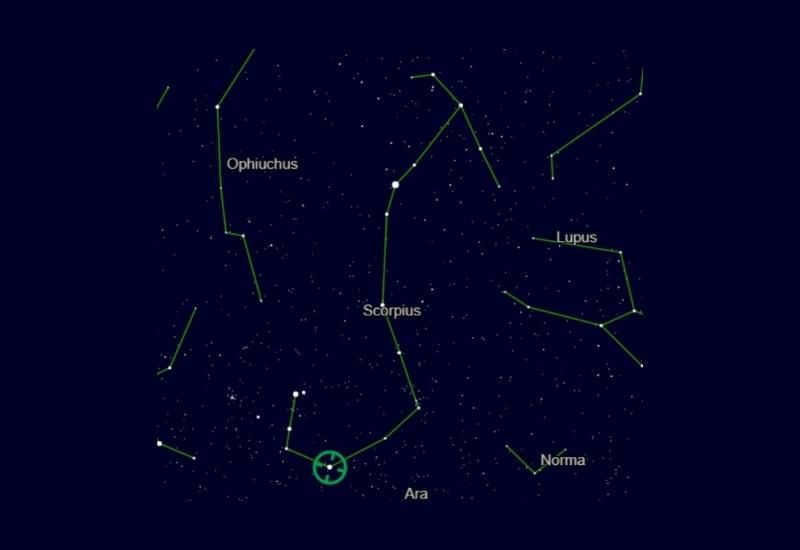
A pulsar and a white dwarf
Located 12,400 light-years away from our planet, this celestial body is composed of two spherical clusters – a white dwarf and a pulsar. It can be found near Messier 4.
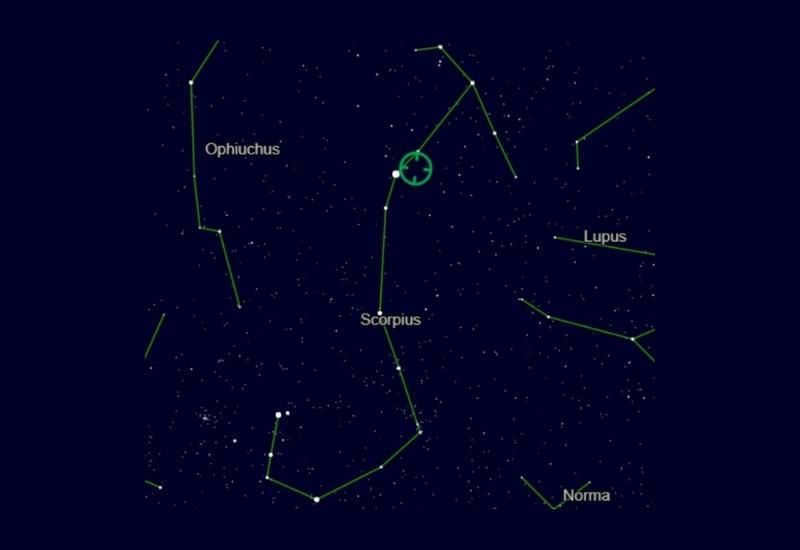
The pulsar travels at a tremendous speed – completing 100 rotations on its axis within just 1 second! Additionally, with each rotation, it emits an electromagnetic pulse directed towards our planet.
Celestial entities found within the Scorpius constellation.
The Scorpius constellation in the night sky encompasses several other captivating astronomical objects.
It’s a cluster of stars. As per researchers, this group is over 12 billion years old!
The key characteristics:
- Visible brightness – 5.9%
- Distance from the celestial body – 7.2 thousand light-years;
- Visual star brightness – 10.8.
M4 was discovered by the astronomer Philip de Lois from Switzerland in the mid-18th century. The cluster was added to the catalog nearly 20 years later.
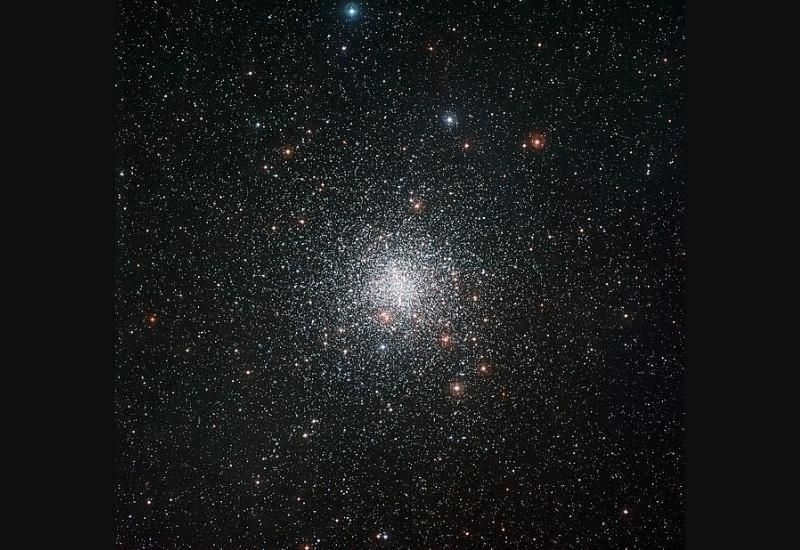
Locating Messier 4 on the celestial map is a simple task – it can be found to the west of the brightest star Antares.
The Butterfly Cluster (M6, NGC 6405)
This cluster bears a striking resemblance to a butterfly. It was initially observed by Italian scientist Giovanni Batista in the 17th century, and later included in Charles Messier’s catalog after 10 years.
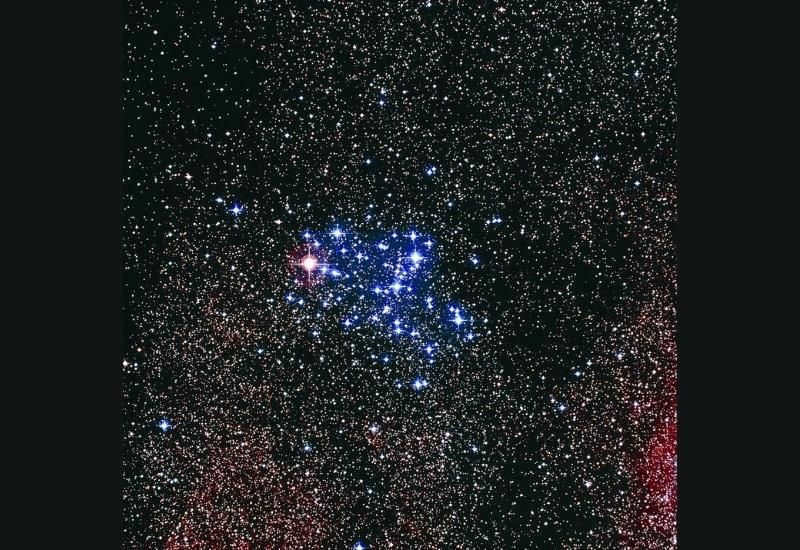
The stars have an apparent magnitude of 4.2. They are located 1.6 thousand light-years away from the solar system.
The Ptolemy cluster (M7, NGC 6475).
M7 is a group of stars situated near the “sting” of Scorpius. It can be easily spotted even without a telescope, and the brightest star in the cluster has a visual magnitude of 5.6.
Messier 7 was first observed by the Greek astronomer Ptolemy in 130. However, without specialized equipment, he was unable to recognize it as a star cluster. He believed it to be a celestial haze.
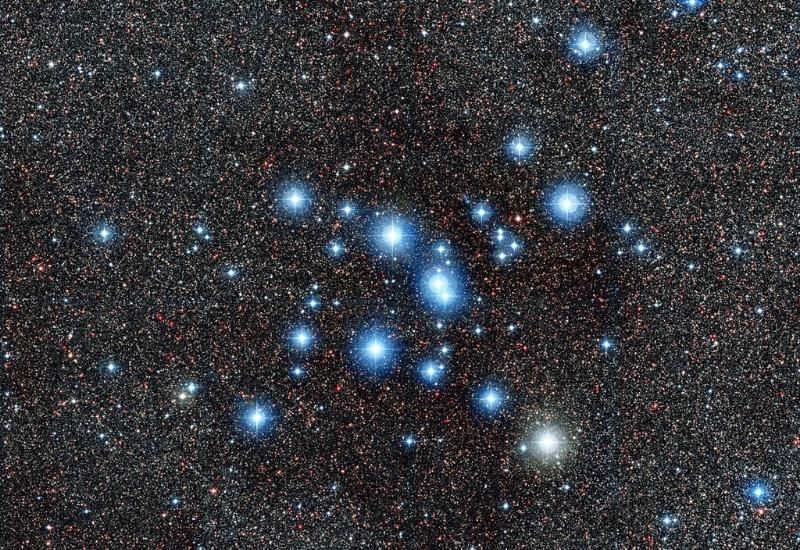

M7 is located at a distance of 980 light years from Earth. It is estimated to be around 200 million years old.
The NGC 6334, also known as the Cat’s Paw Nebula.
This celestial object was first observed by the astronomer John Herschel during the early 19th century. It is a large and active nebula that contains a vast number of stars, many of which are obscured by dense layers of interstellar dust.
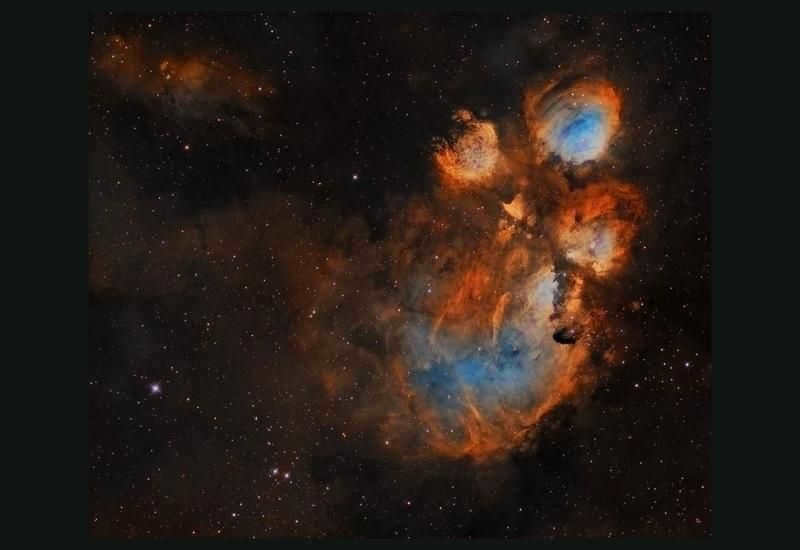
When observing images of the Scorpius constellation, it becomes apparent that this celestial object bears a striking resemblance to the paw of a feline. It emits a vibrant red glow, a characteristic attributed to the abundance of ionized hydrogen atoms within it.
Debunking the Myths Surrounding the Constellation Scorpius
In ancient Greek mythology, the constellation Scorpio represents the Scorpion, which met its demise at the hands of Orion. Upon its death, the creature’s spirit ascended to the heavens. According to the legend, the Scorpion was tasked with eliminating Orion by Gaia, the Earth goddess, as punishment for his hubris and unwarranted self-importance.
However, an alternative version of this tale exists. Artemis, the daughter of Zeus, had a falling out with the hunter Orion. Known for her vengeful nature and unwillingness to forgive, she dispatched a scorpion to deliver a fatal sting. In a display of gratitude, the goddess transformed the creature into the magnificent constellation we know today.

There is also another mythological tale connected to the Scorpio constellation. According to the legend, Helios, the sun god, provided illumination and warmth to our world by traversing the Earth in a solar chariot. His son, Phaethon, desired to experience driving the chariot, and Helios granted him permission.
However, Phaethon soared too high, causing his light and warmth to not reach our planet. As a result, the Earth began to freeze. Undeterred, Phaethon continued to ascend, until he unexpectedly encountered the formidable sting of the Scorpio constellation.
Filled with fear, the son of Helios turned around and began to descend further and further. Eventually, he approached the planet so closely that it suffered partial burns, giving rise to the deserts that now exist on our Earth.
During the first half of summer, when nights are still bright and short in the middle part of Russia, four stars emerge from the southern horizon. They come together to form a shape resembling a fan or a rake used to remove leaves. This arrangement is known as the Scorpius constellation. Specifically, it represents the northernmost part of the constellation. In this article, we will provide information on the best time and location to observe this constellation, as well as introduce you to its brightest stars, nebulae, and star clusters.
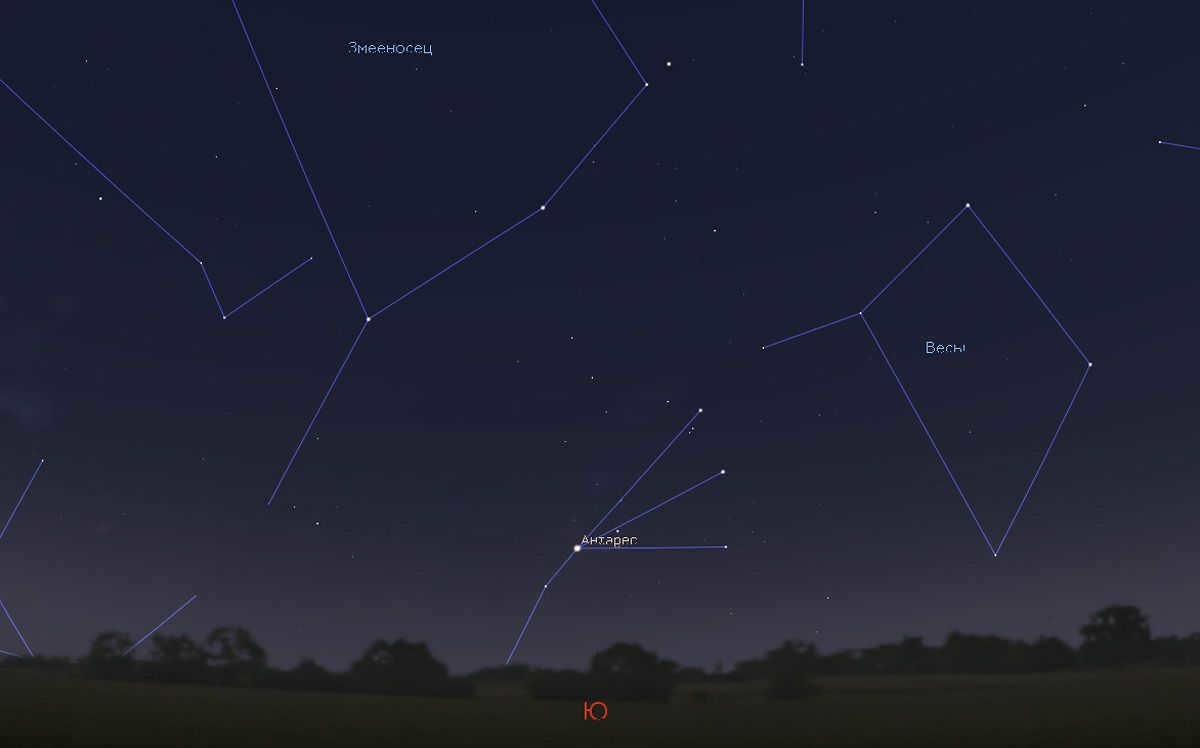
From Moscow’s latitude, only the northernmost part of the Scorpius constellation can be seen. This can be observed in the sky using Stellarium.
The Position of Scorpius
The constellation Scorpius is renowned for its brilliance and distinctive appearance in the night sky. It boasts a remarkable collection of celestial bodies, including a 1st magnitude star, five 2nd magnitude stars, and nine 3rd magnitude stars. These luminous entities are concentrated within a relatively small region of the sky, a feature that sets Scorpius apart from other constellations. It is worth noting that Scorpius lies on the fringes of the Milky Way, a hazy band that encircles the entire celestial sphere. Interestingly, the sections of the Milky Way that intersect with the constellations Scorpio and Sagittarius are particularly vibrant and expansive. When we gaze towards the Milky Way, we are not merely observing the galactic plane; instead, we are peering towards the core of our galaxy, where stars are densely packed. Therefore, the abundance of brilliant stars within the Scorpius constellation is not surprising in the least.
Scheme of the Scorpius constellation, illustrating the positions of the most prominent stars and deep space objects. Source: IAU
What makes it intriguing is that these stars are not randomly scattered across the sky – they actually form a recognizable image of a scorpion! The central region of the constellation (not in a geometric sense, but in terms of visual appeal) is dominated by the bright star Antares, which displays a distinctive reddish hue. From Antares, one can easily trace the main outline of the constellation. To the right of Antares, stars extend outwards, resembling the claws of a predator. The body and long, curved tail extend southeastward from Antares.
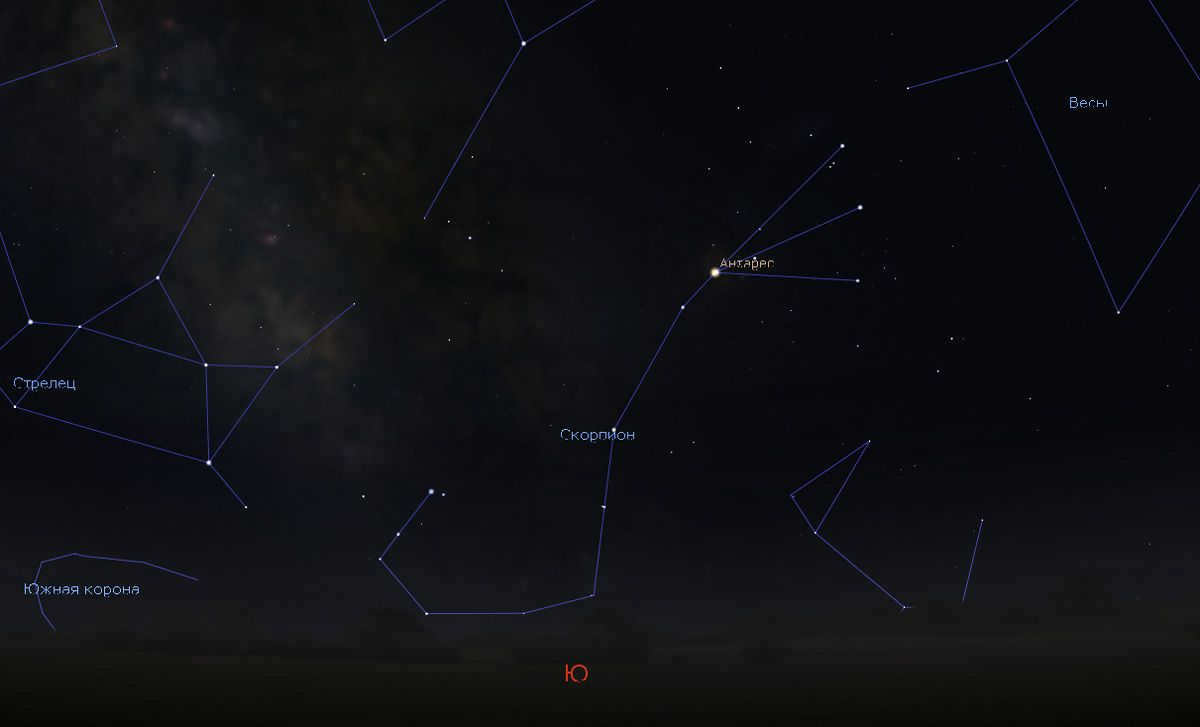
Scorpius, the constellation, can only be fully observed in the southernmost part of Russia, reaching its highest point at midnight in early July. The image provided depicts the view from Sochi. Source: Stellarium
Unfortunately, in the central region of Russia, the tail of Scorpius cannot be seen. To witness the complete Scorpius constellation, one must venture to the southern parts of Russia, such as Sochi or the Caucasus.
Mythical Story of Scorpio Constellation
Undoubtedly, the Scorpio constellation holds a significant place in our celestial sphere, primarily due to its inclusion in the Zodiac. Although its exact origin remains uncertain, it undeniably predates over three or perhaps four millennia.
The Greeks have perpetually referred to this constellation as Scorpio, potentially adopting the nomenclature from their ancient counterparts such as the Egyptians or Assyrians. However, the Greeks wouldn’t be true to themselves if they didn’t endeavor to elucidate the celestial presence of the Scorpion. To accomplish this, they devised a captivating myth surrounding the creation of this constellation.
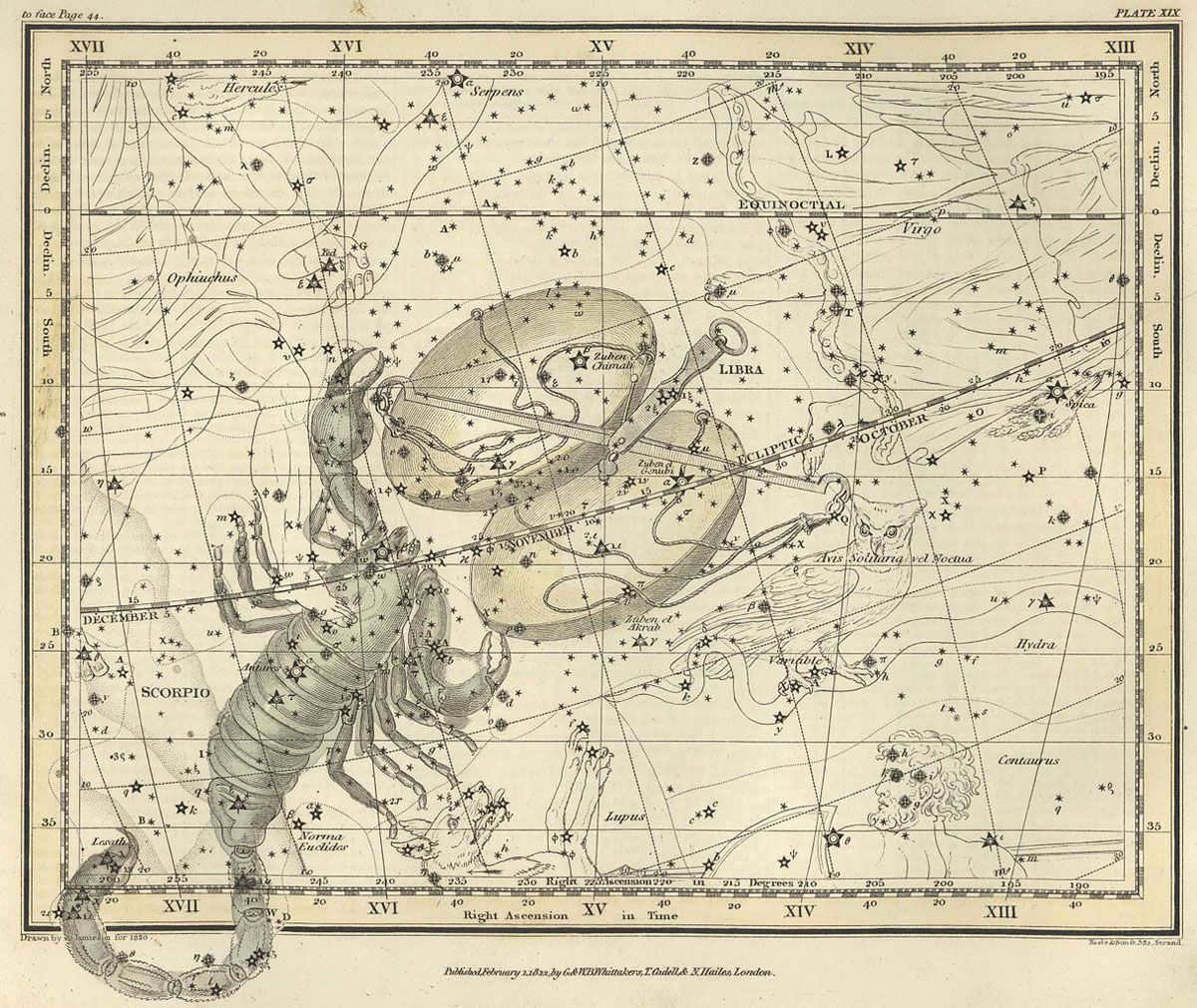
The constellations Scorpio and Libra can be seen in Alexander Jamieson’s 1822 edition of Atas. (Source: USNO)
Artemis was devastated. She pleaded with Aesculapus (also known as Asclepius the Serpent) to bring Orion back to life, but Zeus intervened and prevented it. So, Artemis asked Zeus to place Orion in the sky as well. As a result, both Orion and Scorpius can now be seen in the sky, but interestingly enough, they are in opposite parts of the sky! When Scorpio rises, Orion sets on the horizon, and vice versa. It is said that Orion is still so fearful of the predator that he has moved as far away from it as possible.
Well, the moral of the Scorpio legend is clear: many tragic events could have been avoided if not for vanity and jealousy.
The celestial bodies of the Scorpius constellation
During a night devoid of moonlight, approximately one hundred stars can be observed with the unaided eye within the Scorpius constellation. The majority of these stars are identified solely by numerical designations found in a variety of star catalogs, or by combinations of numbers and letters, such as 18 Scorpius. A few dozen additional stars have been assigned labels corresponding to the Greek alphabet. Finally, only the most radiant stars possess their own unique names.
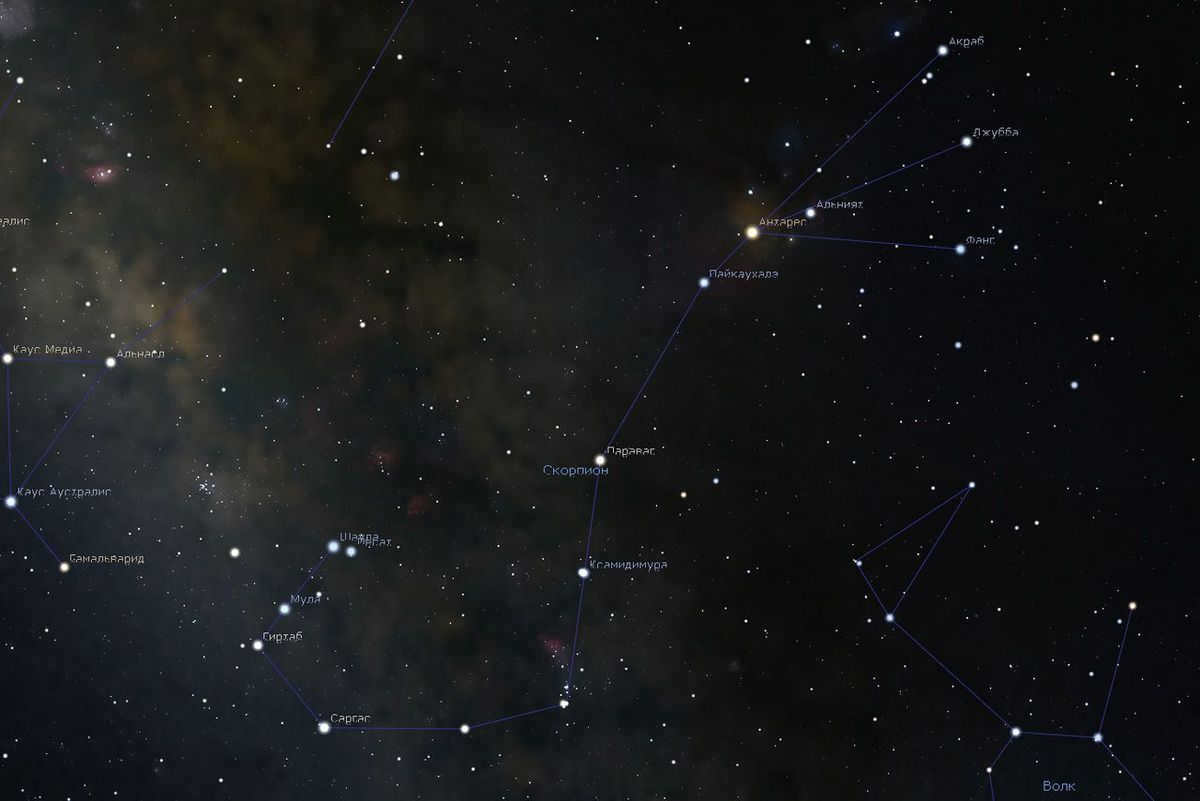
Scorpius is a constellation known for its bright stars. The eastern region of the constellation is located within the dense expanse of the Milky Way. Numerous nebulae emitting light and star clusters can be observed in this area. Image Source: Stellarium
Antares, the brightest star in Scorpius
Antares is the most significant and luminous star in the Scorpius constellation. It holds the 16th position among the brightest stars in the sky, surpassing stars such as Pollux, Deneb, and Regulus, but lagging behind Aldebaran, Betelgeuse, and Procyon. In accordance with the tradition of assigning Greek letters to stars based on their brightness, Antares is designated as the alpha star of Scorpio.
Located in the southern sky, Antares stands out with its intense reddish hue, which captivates observers. The ancient Greeks associated this color with Mars, the god of war. Consequently, the star earned the name Antares, meaning “the rival of Mars” in the celestial realm.
We can mention that Antares is a red supergiant and one of the largest stars known in our Galaxy. Its distance is approximately 550 light-years. Antares also has a companion, a hot star classified as spectral type B, which can be observed with amateur telescopes when atmospheric conditions are favorable.
Shaula, λ Scorpius
Located in the southern part of the Scorpius constellation, Shaula is the second brightest star (with a luminosity of 1.62 m) and is represented on ancient maps as the “sting”. The name Shaula originates from Arabic and translates to “sting”. Shaula is even further away from Antares, approximately 700 light-years from Earth, and has a comparable luminosity to the primary star of the constellation.
Similar to Antares, Shaula is a multi-star system. Through spectroscopic analysis, it has been determined that Scorpius lambda is actually comprised of three stars! The primary component of this system consists of two massive blue supergiants that orbit around a shared center of mass every 6 days. Accompanying this pair is a main-sequence star, which orbits the duo every 1100 days.
For observers located in Moscow and St. Petersburg, Shaula remains below the horizon at all times. To catch a glimpse of this celestial object, individuals must venture to locations south of Volgograd or beyond.
Sargas is the third brightest star in its constellation, with a luminosity of 1.86 m. Similar to Antares, Sargas is a binary star system. The primary component is a bright giant star with a spectral type of F0II. It has a mass three times greater than that of the Sun and shines 1400 times brighter than our own star. Sargas rotates rapidly, resulting in a significant flattening at its poles. Consequently, its equatorial diameter is 36 times larger than that of the Sun, while its polar diameter is only 26 times larger.
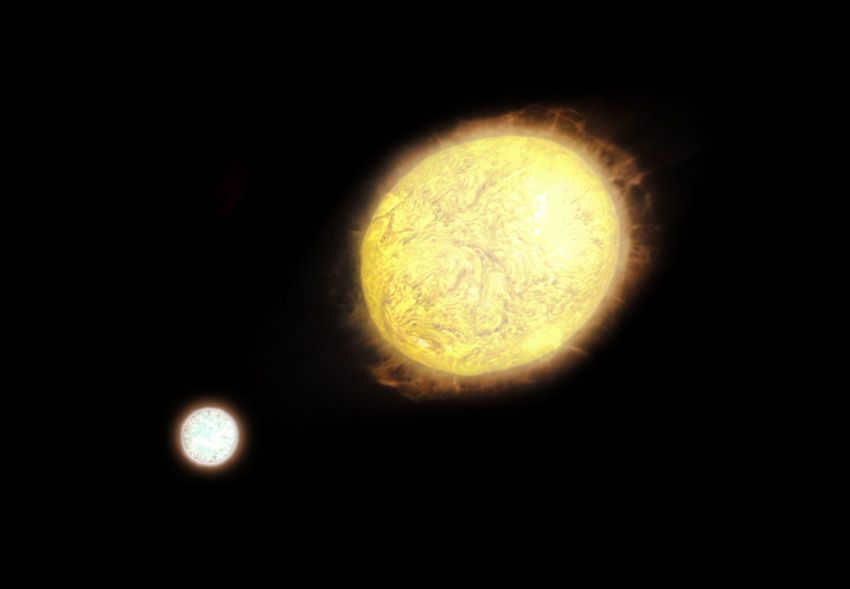
An artist’s rendition of the star Sargas and its companion. Source: Wikipedia
The companion can be seen at an angular distance of 6.5″ from the main star. With a luminosity of 5.3 m, it is easily observable with amateur telescopes. This pair of stars is located more than 300 light years away from Earth.
The name Sargas is believed to have Persian or even older Sumerian origins, though its exact meaning is uncertain. It is one of the southernmost stars in the constellation Scorpius. It can only be observed in the southernmost parts of Russia, around the latitude of Sochi or in Dagestan.
Jubba, δ of Scorpius
As the fourth brightest star (with a luminosity of 2.35 m), Jubba is situated in the claws of Scorpius, to the right of Antares. It is worth noting that Jubba is a double star, comprising of two luminous components that have similar brightness and are separated by a distance of just 0.2 arc seconds. These two stars are hot giants, emitting thousands of times more light than our Sun.
The Delta of Scorpius can be observed not only in southern Russia, but also at latitudes as far north as Moscow and St. Petersburg.
ε Scorpius
Scorpius epsilon, with a magnitude of 2.31, is one of the five brightest stars in the Scorpius constellation. It is the closest and least dangerous of all the stars mentioned above. Epsilon Scorpius is classified as an ordinary giant star and has a spectral type of K1III. It shares many characteristics with the orange star Arcturus in the Volopassus constellation. The main difference is that Epsilon Scorpius is twice as far away from Arcturus, approximately 64 light-years from Earth, making it appear less bright in our night sky compared to Alpha Volopasa.
Located at the base of the celestial predator’s tail, Epsilon Scorpius is south of Antares.
Star clusters and nebulae in Scorpius constellation
For those who enjoy exploring the night sky with binoculars, Scorpius constellation offers a true haven. It is home to numerous bright star clusters, both scattered and globular. Some of them, like the M7 cluster, are even visible to the naked eye! Additionally, Scorpius boasts several fascinating planetary nebulae, including the Beetle Nebula (NGC 6302). Furthermore, the constellation is dominated by stunning star fields that cover almost its entire area. Among these star fields, one can also spot nebular clouds here and there, especially on the eastern edge of Scorpius. These clouds belong to the Milky Way, composed of incredibly distant stars.
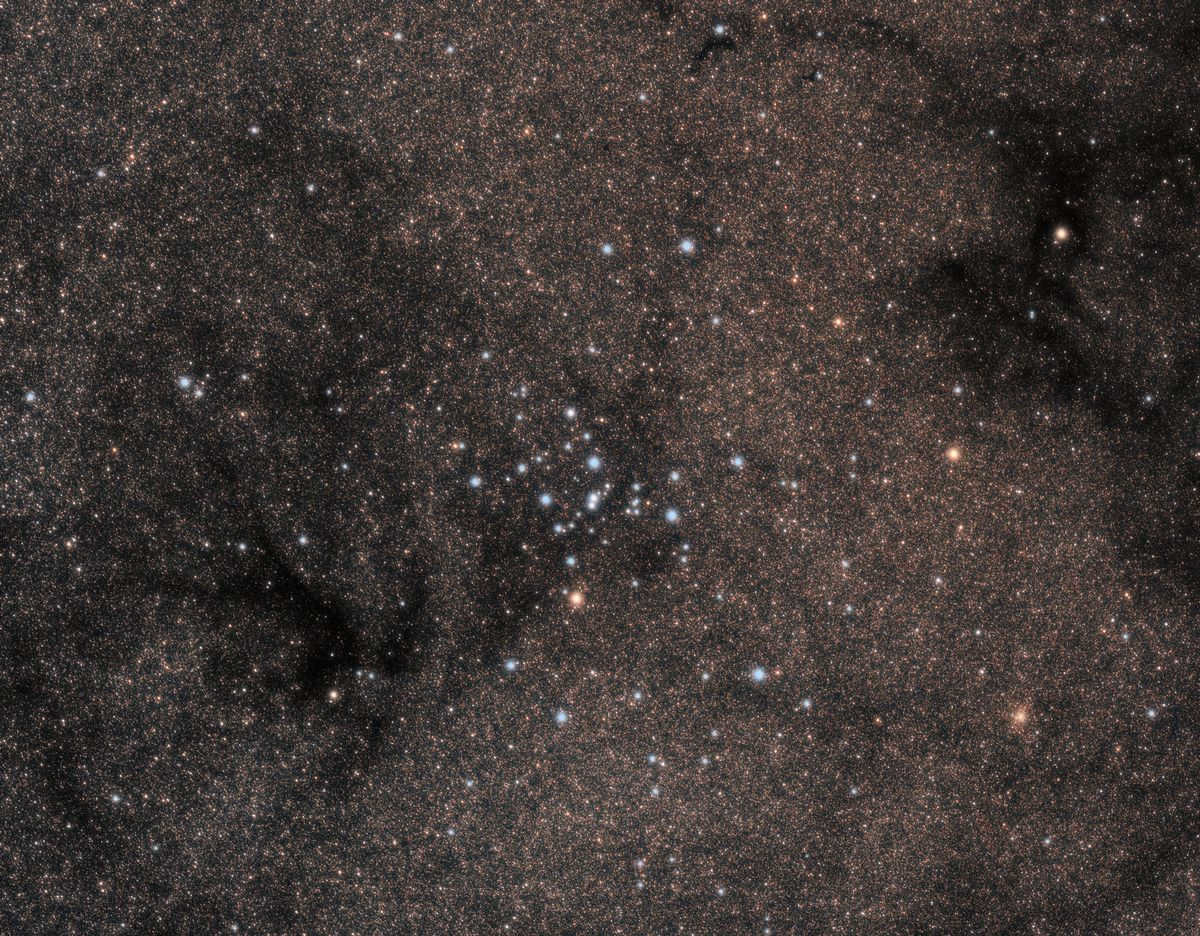
The scattered star cluster M7, also known as the Ptolemaic cluster, can be observed in this image. Take a closer look at the background, where you can see numerous dense star fields that are unsuccessfully trying to hide behind dark clouds of cold interstellar dust. Photo credit: Fernando Oliveira de Menezes
The constellation of Scorpius is known for its abundance of various celestial objects. However, one drawback is that the majority of these objects cannot be seen from Moscow and even less so from St. Petersburg. To catch a glimpse of them, one must travel to the Black Sea coast, the Caucasus, or Vladivostok. A separate article review dedicated to the objects in Scorpius will be published in the future.
Breathtaking star clusters and celestial clouds in the Scorpius constellation
Displayed in the table are the designated numbers, coordinates (right ascension α and declination δ), overall stellar brightness V, size of the objects (D) in arc minutes, classification of the objects, and any additional remarks.
| M7 | 17 hours 54 minutes | -34° 49′ | 3.3 | 80′ | Scattered cluster | Ptolemy cluster, 80 stars |
| M6 | 17 hours 40 minutes | -32° 13′ | 4.2 | 15′ | A scattered cluster | Contains 80 stars |
| NGC 6231 | 16 hours 54 minutes | -41° 48′ | 2.6 | 15′ | Scattered cluster | Caldwell 76 |
| M4 | 16 hours 24 minutes | -26° 32′ | 5.9 | 26′ | Globular cluster | Located near Antares |
| M80 | 16 hours 17 minutes | -22° 59′ | 7.2 | 9′ | Globular cluster | |
| NGC 6302 | 17 hours 14 minutes | -37° 06′ | 9.6 | 1.5′ | Planetary nebula | Beetle Nebula |
| NGC 6124 | 16 hours 26 minutes | -40° 40′ | 5.8 | 29′ | Scattered cluster | Contains 100 stars |
| NGC 6416 | 17 hours 44 minutes | -32° 21′ | 4.7 | 18′ | Scattered cluster | Contains 40 stars |
| NGC 6383 | 17 hours 35 minutes | -32° 34′ | 5.5 | 5′ | Scattered cluster | Contains 40 stars |
The placement of the constellation Scorpius in relation to the ecliptic
As you may be aware, the constellation Scorpius is classified as one of the zodiac constellations. This classification indicates that the ecliptic, which represents the Sun’s annual path against the backdrop of the stars, intersects with Scorpius. It might surprise you to discover that the Sun only spends a week within this constellation, specifically from November 23rd to November 29th, before transitioning into the constellation of Serpentor. However, it’s important to clarify that there is no inherent connection between the zodiac sign Scorpio and the constellation Scorpius. Due to the Earth’s axis precession, the astrological sign of Scorpio no longer aligns with the actual constellation, except for sharing the same name.
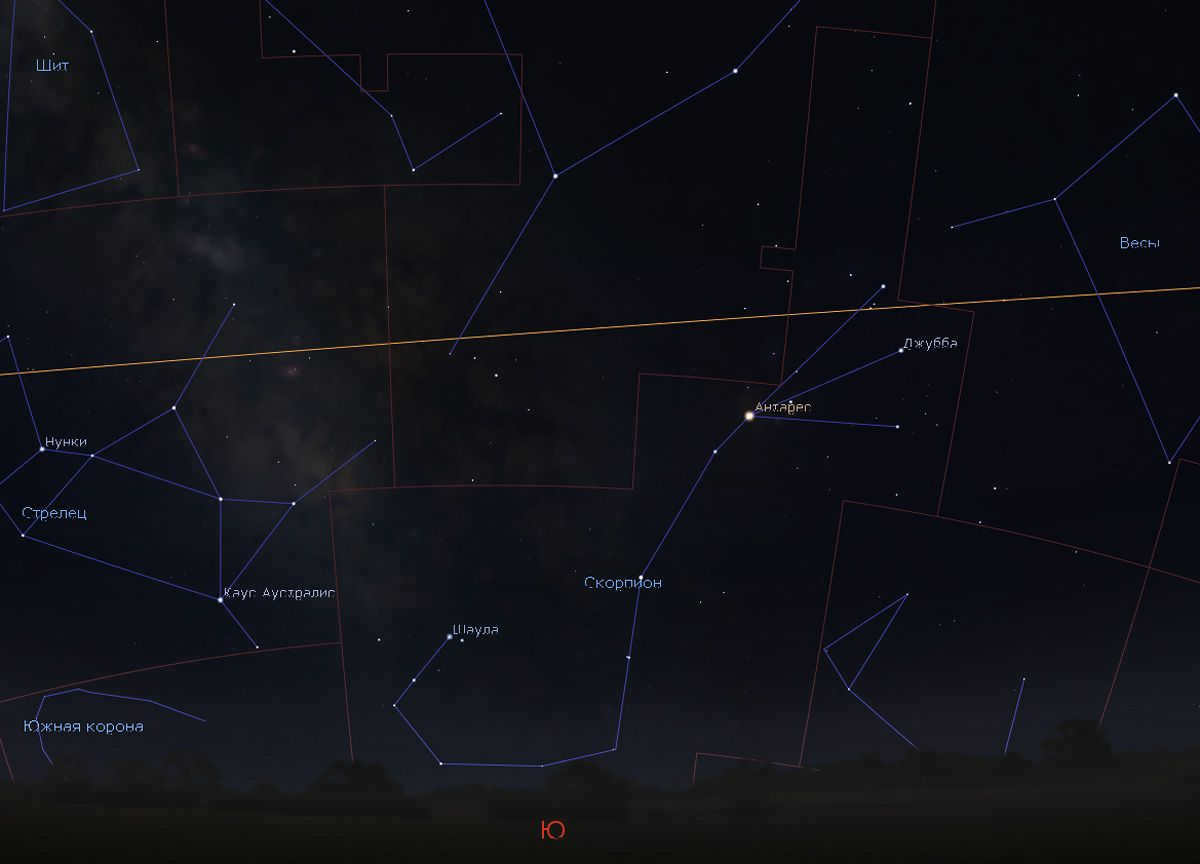
The constellation Scorpius and its position in relation to the ecliptic can be observed on the star chart. The orange line represents the path of the Sun against the backdrop of the stars, while the red markings indicate the boundaries of the constellations. This image was created using Stellarium.
By examining the star chart, it becomes apparent that the Sun traverses the northernmost part of Scorpius, approximately 2 degrees south of the star Aqrab and north of all other prominent stars. The planets and the Moon also follow similar trajectories within this vicinity. Due to the Moon’s orbit being inclined by 5 degrees to the ecliptic, it can be positioned both north and south of the line. As a result, the Moon frequently obscures the star Antares.
Scorpio welcomes new celestial bodies
For a long time, Scorpius has been recognized as a region of the sky where new stars frequently appear. One such occurrence was documented in 134 BC. According to Pliny, this star was observed by Hipparchus, the greatest astronomer of the ancient world. The astronomer was astounded: a star had materialized in the sky seemingly out of thin air! At that time, the prevailing belief was that the celestial realm was immutable. The newfound star eventually vanished, but Hipparchus was so awe-struck that he made the decision to revise the entire collection of stars in the sky. As a result, Hipparchus’ renowned star catalog came into existence. Interestingly, two thousand years later, Edmund Halley, the very astronomer for whom the comet is named, successfully utilized his catalog. Halley compared the positions of the stars in Hipparchus’ catalog with those in several other ancient catalogs, and then compared them to the contemporary positions of the celestial bodies. He discovered that certain stars had undergone significant shifts in the sky over the course of two millennia. This provided evidence that stars are not stationary; they move through space, and the configurations of constellations slowly alter over time.
When it comes to the spring and summer night sky, Antares is often overlooked. This is partly due to the fact that, at the latitude of Moscow and especially St. Petersburg, the star is very low above the horizon even at its highest point in the sky. This makes it difficult to see among the city’s buildings. Additionally, the light from other celestial bodies at the horizon weakens the brightness of Antares. As a result, Antares appears as just an ordinary star that is clearly visible but lacks any distinctive features.
However, Antares is actually a star of the southern hemisphere. To truly appreciate its beauty, one must travel to the southern regions of Russia, such as the Caucasus. There, Antares transforms into a magnificent sight: it shines brighter than Deneb and its fiery red color is truly captivating.
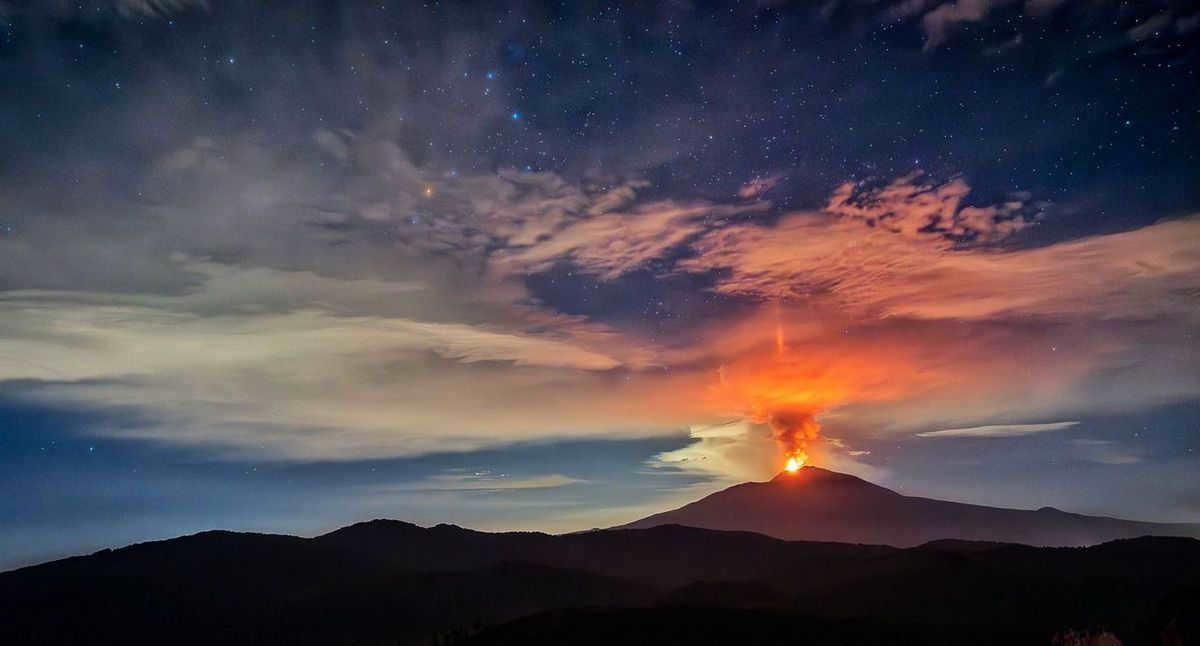
The eruption of Mount Etna in Sicily is captured in this image, with the constellation Scorpius and the star Antares serving as a stunning backdrop. Antares stands out in the photo with its distinct reddish hue. Photo: raffaeledirosa
Antares has long been recognized for its exceptional qualities by scientists. However, it often remains overshadowed by other similar stars, such as the now famous Betelgeuse. In this article, we aim to shed light on some intriguing facts about Antares for amateur astronomers. We have chosen 10 of these facts to illustrate, although it should be noted that the interest in this star extends far beyond just ten facts.
1. Antares stands as the most luminous star in the constellation Scorpius
Antares leads the constellation of Scorpius, whose arrangement showcases one of the most vivid displays in the entire celestial expanse. Within the series of stars extending from the star Aqrab (Scorpius bata) to Shaula (Scorpius lambda), it is effortless to discern the depiction of a nocturnal hunter with a curved tail.
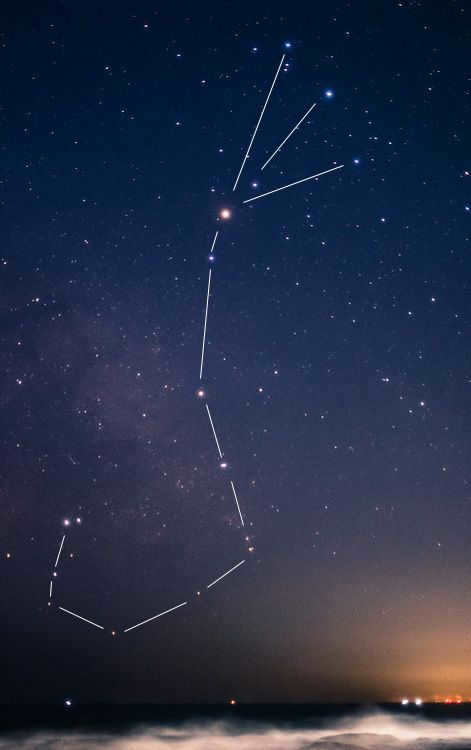
The Scorpius constellation and the star Antares can be seen at sunrise. Picture taken by Munetaka Hirosaki
Unfortunately, in most parts of Russia, the Scorpius constellation is only partially visible or not visible at all in the northern regions. Antares is located in the northern part of the constellation, which means it can be observed south of 63° north latitude. This latitude is roughly equivalent to the cities of Petrozavodsk, Syktyvkar, Surgut, and Yakutsk. However, the challenge is that the best visibility of Antares in these regions coincides with the season of white nights. So, it would be more reasonable to search for Antares in the sky a bit further south, at least at the latitude of St. Petersburg (60° N).
Antares, which means “Heart of the Scorpion” in Latin, was depicted on ancient maps as a star in the body of a scorpion. This name is a distorted version of the Arabic term “Kalb al Aqrab.” In medieval times, astronomers in the Arabian Peninsula referred to it as Scorpion’s Heart.
In 1603, Johann Bayer published Uranometria, an atlas of the night sky. In this atlas, the bright stars in constellations were labeled with Greek letters based on their brightness. Antares was labeled as Alpha Scorpius since it was the brightest and most prominent star in the constellation. This practice of designating bright stars with Greek letters has since been adopted as the official and widely accepted convention in astronomy. Therefore, it is not uncommon to see Antares referred to as α Scorpius, α Scorpii, or α Sco.
2- Antares: Mars’ Competitor in the Celestial Sphere
Throughout history, numerous astronomers have characterized Antares as a vivid shade of red. This depiction is remarkably accurate! Picture the vibrant flames of a roaring bonfire. Rather than being a simple red or maroon hue, Antares exhibits a striking golden-orange coloration when observed on a moonless night.
The intense red tint of this celestial body has been linked by various cultures to the color of blood. Consequently, it has been bestowed with different names by different civilizations, such as “Fiery” in ancient Chinese, “Antares” in Greek mythology, and “Heart of Scorpio” in Arabian and European lore.
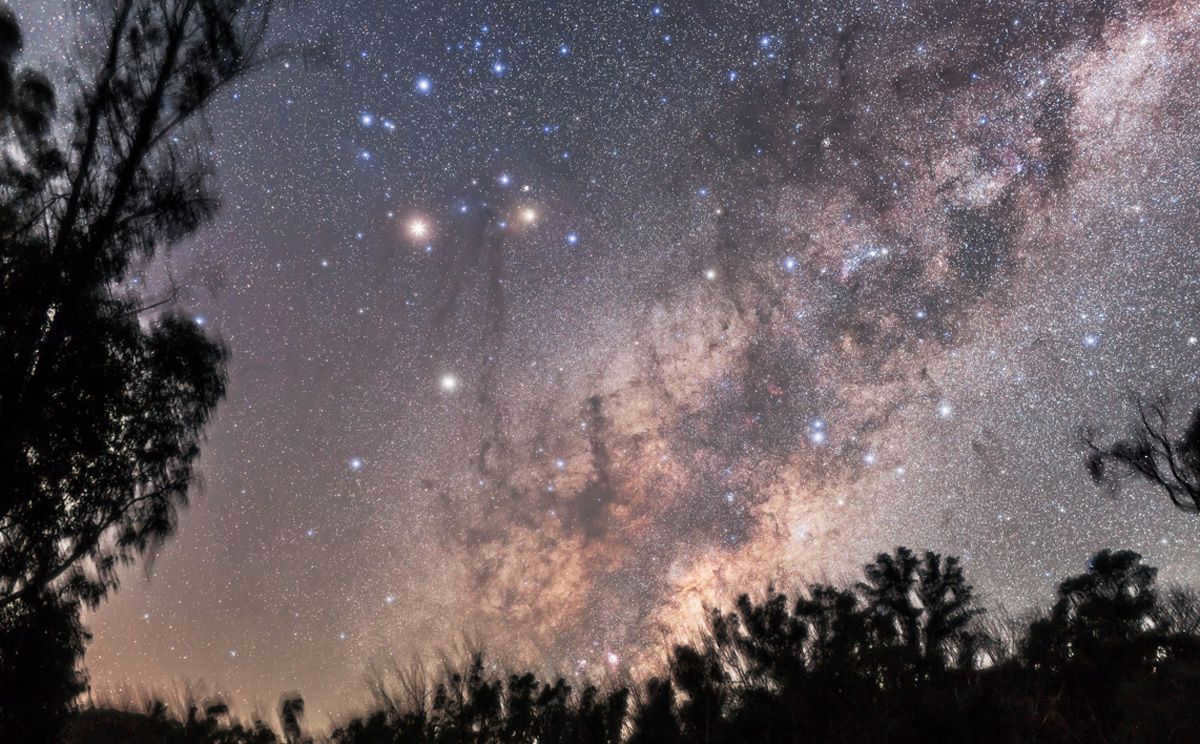
In this photograph, we can see the beautiful Milky Way and the constellation of Scorpius. The most prominent elements are the planet Mars and its celestial counterpart, the star Antares. Both of them exude a captivating reddish glow, with Mars being the most radiant object captured in this image. Positioned slightly above and to the right of Mars, we can admire the majestic presence of Antares. This stunning photo was taken by the talented Alan Dyer.
Contemporary astronomers employ photometric techniques to determine the color of celestial luminaries rather than relying on visual observation. These techniques involve measuring the intensity of light that passes through various filters. Interestingly, the B-V value, which represents the difference in luminosity between the blue filter and the filter used for visual observation, tends to be very similar for both Antares and Mars. This indicates that both luminaries experience a similar degree of “reddening.” However, Mars occasionally undergoes slight changes in color. These changes are attributed to seasonal variations on the planet and the occurrence of dust storms. In contrast, recent research suggests that Antares has maintained a consistent color for thousands of years.
3. Physical Characteristics of Antares
Antares possesses some truly astounding physical attributes. Certain aspects of this star are absolutely mind-boggling.
The Size of Antares
First and foremost, Antares is among the largest stars within our galaxy. Its diameter is at least 700 times that of the Sun. This figure is only an approximation and primarily represents the lower limit of the star’s size. More realistic estimates range from 850 to 900 solar diameters. What accounts for this variation? It is partially attributed to inaccuracies in measuring the star’s distance. Another factor is the star’s pulsations. However, the most significant factor is the ambiguity surrounding the boundary between Antares and outer space. Nevertheless, we will delve into this matter further in the following section on the star’s atmosphere.
When it comes to popular articles on astronomy, they often like to replace the Sun with giant stars and illustrate how the Solar System would be affected. We don’t want to miss out on such a delight, so let’s imagine that Antares has taken the place of our beloved star. In this scenario, all the planets, including Mars, would face a dire fate: they would be engulfed by Antares. Antares is so immense that it would consume Mercury, Venus, Earth, Mars, and even a portion of the asteroid belt! Jupiter would find itself within the chromosphere of Antares, while Saturn would be located in the vicinity of a powerful stellar wind.
Distance to Antares
Antares presents a challenge when it comes to measuring its distance directly due to its remote location. The star’s parallax shift is incredibly small, making it more convenient for astronomers to estimate the distance using indirect methods. Fortunately, the Hipparcos satellite was able to measure Antares’ parallax in the late 1990s, revealing an angle of just 0.00589 seconds of arc, which is equivalent to 1/610000 of a degree! To put this into perspective, if we were observing our own Sun from the Antares system, this would be the angle that separates the Sun and Earth.
With a parallax value of 0.00589 arc seconds, the distance to Antares is estimated to be around 170 parsecs or approximately 550 light years. This means that the light emitted by Antares today will only reach Earth after a span of five and a half centuries! However, it’s important to note that there is a margin of error in this measurement, with at least 30 parsecs or 100 light-years of uncertainty.
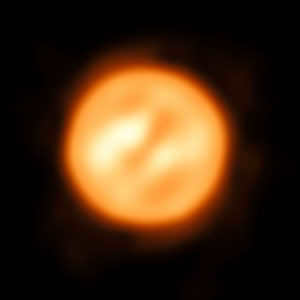
An image of Antares has been created using the VLTI interferometer of the European Southern Observatory, making it one of the most detailed images of a star’s surface, second only to our Sun. Source: ESO/K. Ohnaka
Interestingly, determining the relative size of Antares is actually easier than measuring its parallax, due to the higher angle at which its disk is observed! This can be understood by considering the fact that Antares is several times larger than the orbit of Earth around the Sun. Consequently, astronomers have been able to not only measure the star’s radius, but also construct an image of its disk!
To achieve this goal, we utilized the interferometry technique. Two telescopes positioned several hundred meters from each other were directed towards Antares simultaneously. As a result, the resolving capability of the telescopes was enhanced to the extent where their primary mirrors appeared to have a diameter equal to the distance separating them. Consequently, we were able to combine the data from both telescopes to create a comprehensive image of Antares’ disk and generate a detailed chart depicting the luminosity distribution across its surface.
The brightness of Antares
Antares shines in the sky with a luminosity of around 1.1 m, earning it the 16th spot on the list of the most radiant stars. It is worth noting that along the path to Antares, there are interstellar clouds comprised of gas and dust, which diminish the star’s brightness by approximately half a magnitude. Without these dust particles, Antares would easily secure a place among the top ten brightest stars in the sky!
So, what exactly is the luminosity of this celestial body? Considering its distance, we can conclude that Antares is at least 75,000 times more luminous than the Sun! That’s like having a cosmic spotlight in the sky!
The classification of Antares in terms of its spectrum
When astronomers embark on studying a star, their initial step involves examining its spectrum with meticulous attention. The spectrum of a star reveals numerous enigmas: it provides valuable insights into the star’s physical attributes, such as its internal structure, magnetic field, and even the presence of a companion. All of this information can be gleaned solely from the spectrum, without the need for measurements of the star’s distance, size, or luminosity.
Antares bears the spectral classification M1.5Iab-Ib + B2V..
What does this classification signify? Let’s unravel its meaning. Firstly, the initial segment of the spectrum. The spectral class M denotes that the star falls into the category of cold red stars. In fact, Antares is a red star, with a surface temperature of 3660 degrees on the Kelvin scale, which is approximately 3400°C.
Moreover, the Roman numeral I indicates that it is classified as a supergiant star. As mentioned previously and reiterated here, astronomers who study spectroscopy confirm the veracity of this classification: Antares is one of the largest stars in the entire Universe.
Using the Latin alphabet, ab and b represent supergiants with medium luminosity (ab) and low luminosity (b) respectively. Thus, the designation Iab – Ib indicates that Antares falls between the category of low luminosity and medium luminosity supergiants. (Are there even more luminous supergiants? Absolutely! There exist stars that emit a million times more light than our Sun.)
Following the star’s spectrum, we come across a positive sign. This indicates that Antares’ spectrum is complex, indicating that the spectrum effectively conceals two stars in very close proximity to each other. The second star is Antares’ counterpart, a hot star classified as spectral class B, with a bluish-white hue and positioned, much like our Sun, on the main sequence (luminosity class V). That’s more or less accurate, but we will discuss Antares’ counterpart in more detail later on.
Supergiants are celestial bodies in their final stages of development. They are luminous objects that have already depleted all the hydrogen in their core, transitioning to helium and other chemical elements. Hence, from an evolutionary standpoint, these stars are considered to be advanced in age. In terms of the cosmic timescale, stars like Antares have a short lifespan. Antares, for instance, is estimated to be a mere 11 to 15 million years old. (Not billions, but millions!) In other words, this star came into existence long after the extinction of dinosaurs on Earth.
What caused Antares to age at such an accelerated rate? Clearly, it was due to the nuclear reactions occurring at its core, which happened at a much faster rate compared to the Sun. The rate of these nuclear reactions is dictated by the temperature within the star’s core, and the temperature, in turn, is influenced by the star’s mass.
Astronomers have made calculations and determined that Antares is approximately 14 times more massive than the Sun, making it an extraordinary and rare star. In fact, less than 1% of stars in the Galaxy possess such a tremendous mass.
4. Antares exhibits variability as a pulsating star.
Similar to all red supergiants, Antares is classified as a variable star. This means that the star’s luminosity experiences smooth changes over time. These fluctuations occur within a broad range, with Antares sometimes reaching a brightness level as high as Altair from the Summer Triangle, while other times it may resemble Dubhe from the Big Dipper. At its maximum, Antares is nearly three times brighter than at its minimum!
Astronomers categorize Antares as a slow irregular variable star, belonging to the Lc class. Other stars in this group include Aldebaran from the Taurus constellation and Enif from the Pegasus constellation.

A chart showing the changes in brightness of Antares over a period of 70 years, from 1945 to 2015. The X axis represents time, while the Y axis represents the star’s brilliance. This data was compiled by the AAVSO (American Association of Variable Star Observers).
The fluctuations in Antares’ brightness are primarily caused by radial pulsations. By analyzing the star’s radial velocity, astronomers T. Pugh and D. Gray have identified a 6-year pulsation period, during which the star undergoes small variations in brightness. Over this period, Antares goes through cycles of expansion and contraction, with its radius varying by up to 19%.
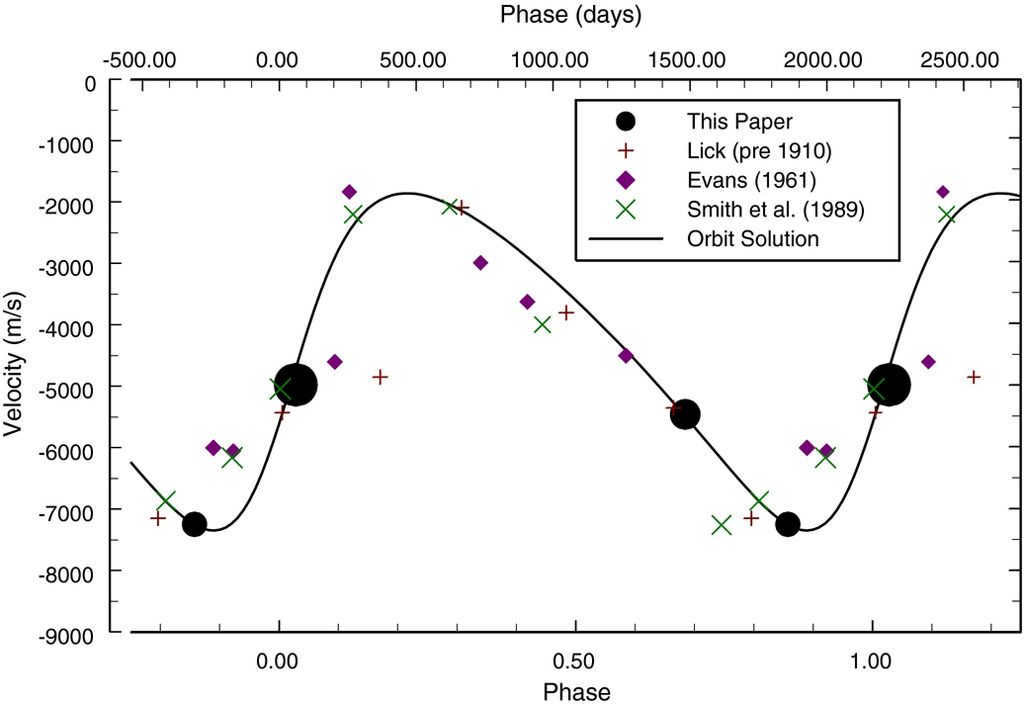
Astronomers have been observing Antares for more than a century and have found that its radial velocity, which measures its speed towards or away from Earth, varies over a period of 2167 Earth days. This information was gathered by T. Pugh and D. F. Gray in 2013.
Another factor that affects Antares’ brightness is the release of dust clouds into its atmosphere.
On the other hand, Antares is not widely known among amateur stargazers. In fact, it poses a challenge to observe due to its low position above the horizon in the central region of Russia. In the southern part of the country, there is another obstacle: the search for appropriate stars for comparison. The prominent stars Altair, Deneb, and Vega are too distant and also share a white color, which can introduce inaccuracies in light measurements. The only solution is to utilize electronic light recording devices for observing Antares.
5. Antares is a binary star system
As previously mentioned, the Antares system is comprised of two stars. Up until now, we have focused on the primary star, Antares A. However, its companion, Antares B, is equally noteworthy. Antares B is a high-temperature star with a radius that is 5 times larger than that of the Sun and a mass that is 7 times greater. Additionally, Antares B emits 2800 times more light than our Sun during the daytime.
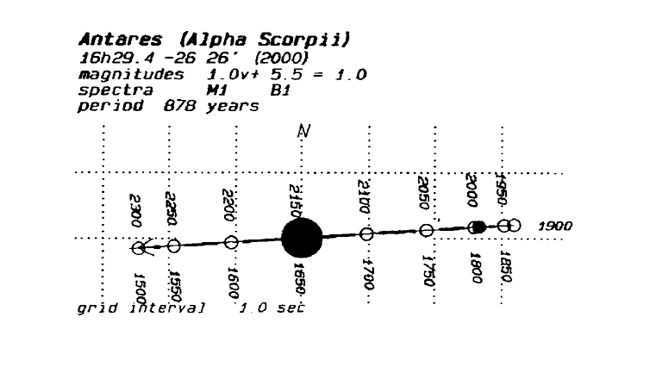
Antares B revolves around Antares A. The shaded circle on the diagram indicates the satellite’s location in 1994. As depicted in the illustration, the angular separation between the stars is presently gradually diminishing. Source: Fred Schaaf. The Brightest Stars
Nevertheless, Antares B is significantly inferior to its parent star. Its emitted radiation makes such a minuscule contribution to the overall luminosity of the system that we would have been unaware of its presence if not for the telescope.
Observing Antares B with medium and large amateur telescopes can be challenging. This is due to several factors. Firstly, its close proximity to its host star, with an angular distance of only 2.5 seconds, makes it difficult to distinguish. Additionally, the bright light emitted by Antares A obscures the light from its companion. Furthermore, Antares is often positioned low on the horizon, which can result in poor visibility. The turbulent air near the horizon often causes the star’s image in the eyepiece to become blurred, causing both stars to appear as a single, shimmering point of light.
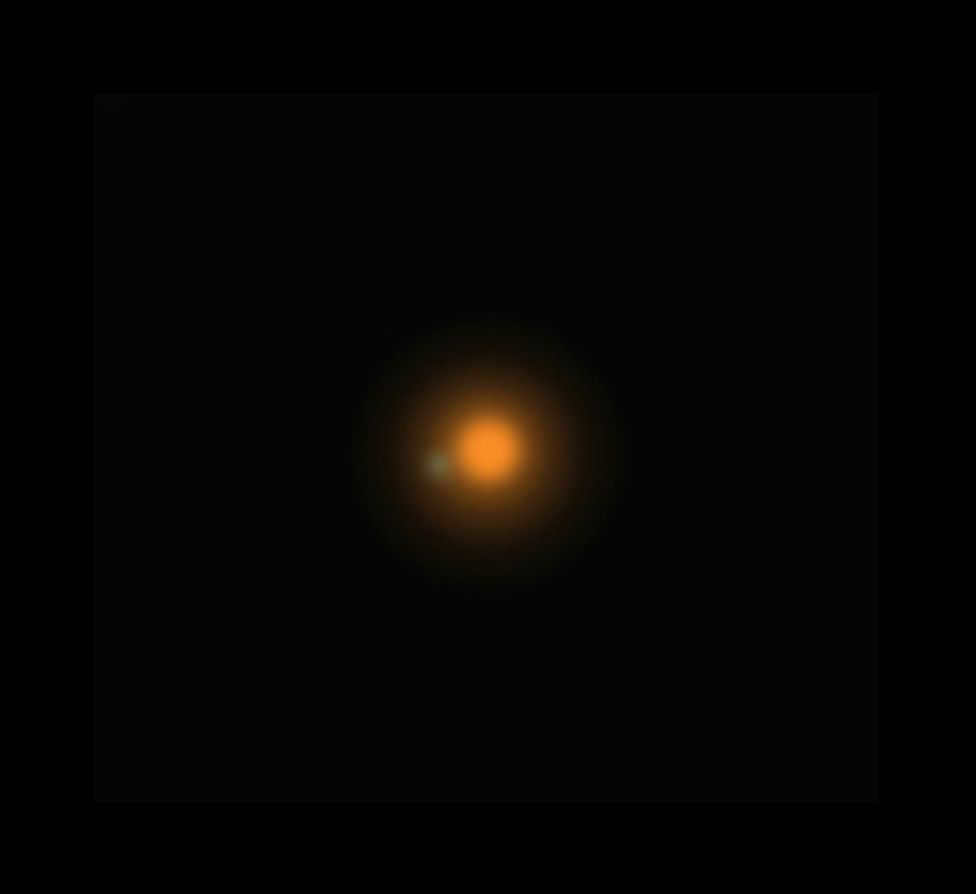
A representation of the Antares A and Antares B stars, captured through observations using a 350-mm Newton reflector with a magnification of 400×. Photograph: Richard Handy
Antares is often admired by many observers due to its striking double star appearance. When viewed through a telescope, the primary star exhibits a captivating golden-orange hue, while its companion star appears green. It is important to note that green stars do not naturally exist, but in this particular case, the contrasting colors of the two components contribute to an extraordinary visual experience.
6. Occurrences of Antares being covered by the Moon and planets
Situated in the zodiacal constellation Scorpio, Antares is positioned just 4.5° to the south of the ecliptic, which is the pathway of the Sun as it moves across the backdrop of the stars. This implies that the Moon and planets (including Mars, which Antares “competes” with) have the potential to come into close proximity with Antares. In addition to Aldebaran, Regulus, and Spica, alpha Scorpius is one of four stars with a first magnitude that can undergo an occultation by the Moon. These celestial events where a star is temporarily obscured by the Moon are referred to as “coverings”.

The Moon will pass in front of Antares multiple times between 2021 and 2040. The map displays the specific areas on Earth where this celestial phenomenon will be visible. Source: mkrgeo-blog.com
Additionally, Antares can also be eclipsed by planets, although these occurrences are quite infrequent. It is worth noting that the next event of this kind will take place on November 17, 2400, when Venus will pass in front of Antares, causing an eclipse.
7. The Surroundings of Antares
When observing Antares through binoculars, one can’t help but admire its location in the sky, which is truly picturesque. In close proximity to this star, you will find the vibrant globular star cluster M4, as well as several scattered clusters. These celestial objects can all be easily observed using binoculars or a small telescope. Additionally, Antares is surrounded by both dark and light nebulae, while a strip of the Milky Way is situated relatively close to the star. It’s worth noting that these fascinating sights are best viewed from southern latitudes, where Antares rises high above the horizon.
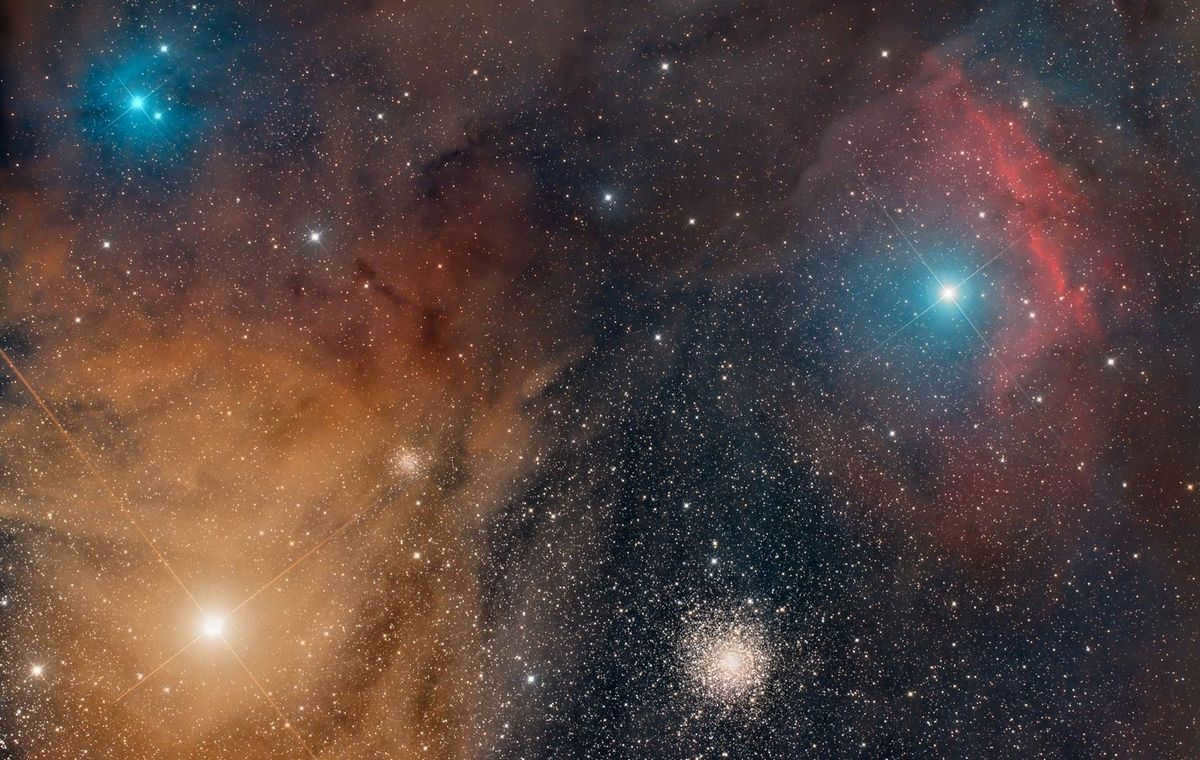
Antares and its surrounding area are beautifully captured in this stunning image. Antares, located in the lower left corner, is surrounded by a massive cloud of interstellar dust, which is part of the Rho Serpentine interstellar cloud complex. At the top of the image, we can see Serpentor’s Rho, a blue star that is immersed in a nebula reflecting the light from Antares. Adjacent to the star, there are two globular star clusters, NGC 6144 and M4 or Crab cluster, which are located relatively close to Earth. To the right side of the photo, we can observe a hydrogen emission cloud enveloping the star Alniyat, also known as sigma Scorpius. This captivating photo was taken by Davide Mancini.
Long exposure photos reveal an even more awe-inspiring sight of Antares. Positioned at the periphery of the expansive Rho (ρ) gas-dust complex of the Serpentine, this star is surrounded by a collection of dark, reflective, and emission nebulae. Within these nebulae, the process of star formation is currently underway. Interestingly, it is the radiance emitted by Antares that serves to illuminate the gas and dust clouds within the reflective nebulae of Rho Serpens, causing them to stand out with a distinct bluish luminescence against the backdrop of the cosmos.
8. Antares possesses an expansive and constantly changing atmosphere
Have you ever pondered where exactly the Sun’s edge lies? given that it lacks a solid surface? When astronomers refer to the Sun’s size, they conceptualize the Sun’s boundary as the photosphere. The photosphere. is a thin layer of intensely hot gas where the opacity of material significantly diminishes. Consequently, this plasma layer, when observed through a telescope, distinctly demarcates the limits of the celestial body.
Schematic of Antares’ Atmosphere
The composition of Antares’ atmosphere follows the typical pattern of dying stars. On one side, it seamlessly merges with the photosphere, while on the other side it transitions into a robust stellar wind. This stellar wind consists of a dense stream of charged particles that rapidly disperse into outer space. Recently, the use of radio observations from the ALMA and VLA telescopes has enabled scientists to construct a comprehensive diagram of Antares’ atmosphere.
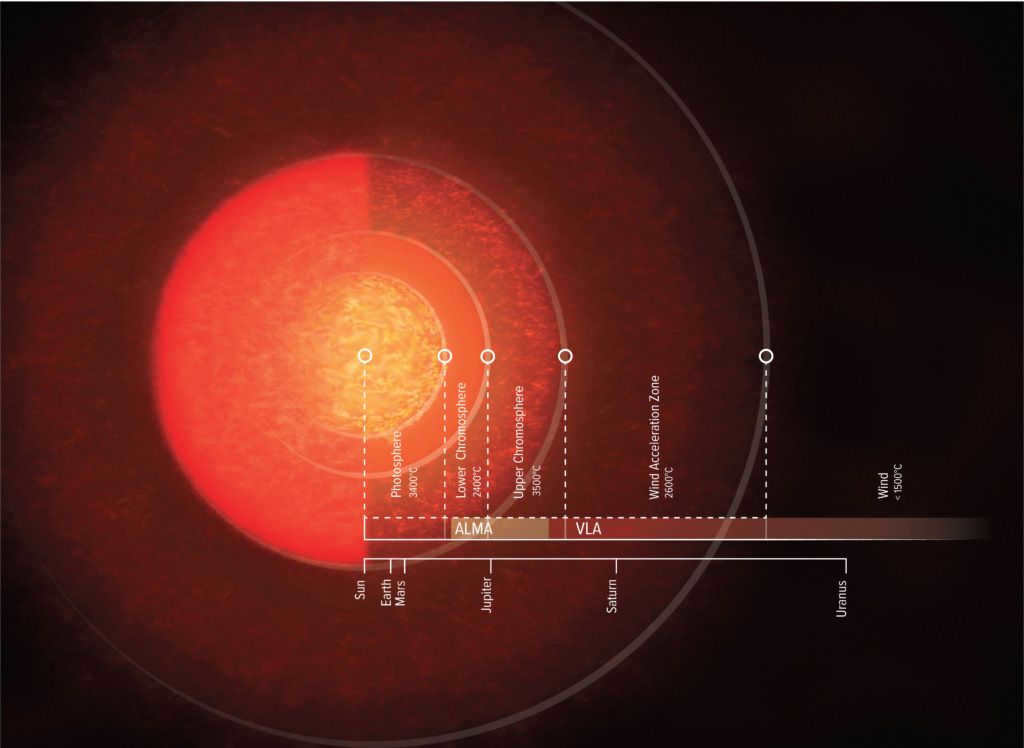
The atmosphere of Antares is quite remarkable. If this star were positioned at the center of our solar system, its atmosphere would extend between the orbits of Mars and Jupiter. The lower atmosphere, which is denser and has a temperature of 2400°C, would encompass the area up until the orbit of Jupiter. The upper layer, which is hotter, known as the chromosphere, would reach as far as Saturn. Lastly, the outermost layers of Antares’ atmosphere would stretch out to the outer reaches of our solar system, where the planet Uranus is located. This fascinating visualization was created by NRAO/AUI/NSF, S. Dagnello.
Unlike the Sun, the atmosphere of Antares (or, the chromosphere, to be exact) stretches out to a distance that is 2.5 times the size of the star. What’s interesting is that the chromosphere of Antares is remarkably chilly, with a temperature of just 3500°C (compared to the Sun’s scorching 20000°C!). Furthermore, astronomers have observed the outermost layers of Antares’ atmosphere as far as 12 times the radius of the star!
9. Antares is predicted to undergo a supernova explosion in the near future
If you are familiar with the characteristics of giant stars, you may have noticed that Antares bears a striking resemblance to another red supergiant star, Betelgeuse. Both stars have similar mass, luminosity, spectral class, and age. Additionally, the distance between Antares and Betelgeuse is approximately the same. Betelgeuse may appear brighter, but this difference can be explained by the presence of interstellar dust clouds that partially absorb Antares’ light on its way to us. Interferometric methods have also provided similar details on the surface of these stars, revealing the presence of giant light and dark spots known as convective cells, which are hundreds of times the size of the Sun.
When will this event occur? Nobody knows for certain: it could be tomorrow, or it could be in 10,000 years. Regardless, in comparison to the vastness of the universe, it is an insignificant amount of time.
10. Antares and the future of stars
When observing the timeless image of constellations, it may appear that the cosmos is motionless. However, this is not the case. Our galaxy is teeming with activity: stars are being born and dying, supernovae are erupting, and new planets and black holes are being formed. Additionally, the matter within the galaxy is evolving. In its early stages, the Milky Way was primarily composed of hydrogen and helium. Today, the interstellar medium contains nearly all the elements found in the periodic table.
Where did they originate? All of them were created within the depths of stars. This includes carbon, nitrogen, and oxygen, which serve as the fundamental components for life on Earth. Up until now, enormous stars have been the primary sources of all the essential elements necessary for life, including iron and phosphorus. It is within their cores that the necessary conditions for the creation of all elements up to iron exist, and during a supernova explosion, all heavier chemical elements are formed.
These elements – the building blocks for future planets and stars – depart from stars in two ways. The first is through a supernova explosion. Following the explosion, the enriched material disperses throughout the Galaxy, where it further mingles with hydrogen clouds. The second method is less dramatic and occurs through stellar wind.
The solar wind is famous for creating stunning displays of light known as auroras. However, the stellar wind emitted by a star like Antares is significantly more powerful. As Antares approaches the end of its life, it expels matter with incredible force. It is estimated that Antares sheds approximately 1/200th of the Earth’s mass annually, which is nearly equivalent to half of the Moon’s mass! This remarkable phenomenon is solely attributed to the influence of the stellar wind.
In the future, the particles released by Antares will eventually cool down and merge with interstellar clouds. It is intriguing to consider that these particles may one day contribute to the formation of a new star, and perhaps even a new Earth.
The star Antares. A brief overview
Constellation: Scorpio
Distance from Earth: 170 ± 30 parsecs
Distance from the center of the galaxy: approximately 550 light-years
Antares A
Apparent Magnitude: 1.08 m (variable)
Spectral Class: M1.5Iab-Ib
Luminosity (compared to the Sun): approximately 75,000 times brighter
Color: Red
Surface Temperature: 3,660 Kelvin
Diameter (compared to the Sun): approximately 700 times larger
Mass (compared to the Sun): approximately 12 times greater
Age (in millions of years): 15 million
Absolute Visual Magnitude: -5.28 m (variable)
Antares B
Brilliance: Approximately 5.5 m
Spectral classification: B2.5V
Luminosity (compared to the Sun): 2754
Color: Blue
Temperature: 18500 K
Diameter (compared to the Sun): 5.2
Mass (compared to the Sun): 7.2
Age (in millions of years): 15
Absolute stellar magnitude Mv: -0.8 m
Equatorial coordinates of Antares:
Right Ascension (2000): 11h 03min 24.4597s
Declination (2000): -26° 25′ 55.2094″
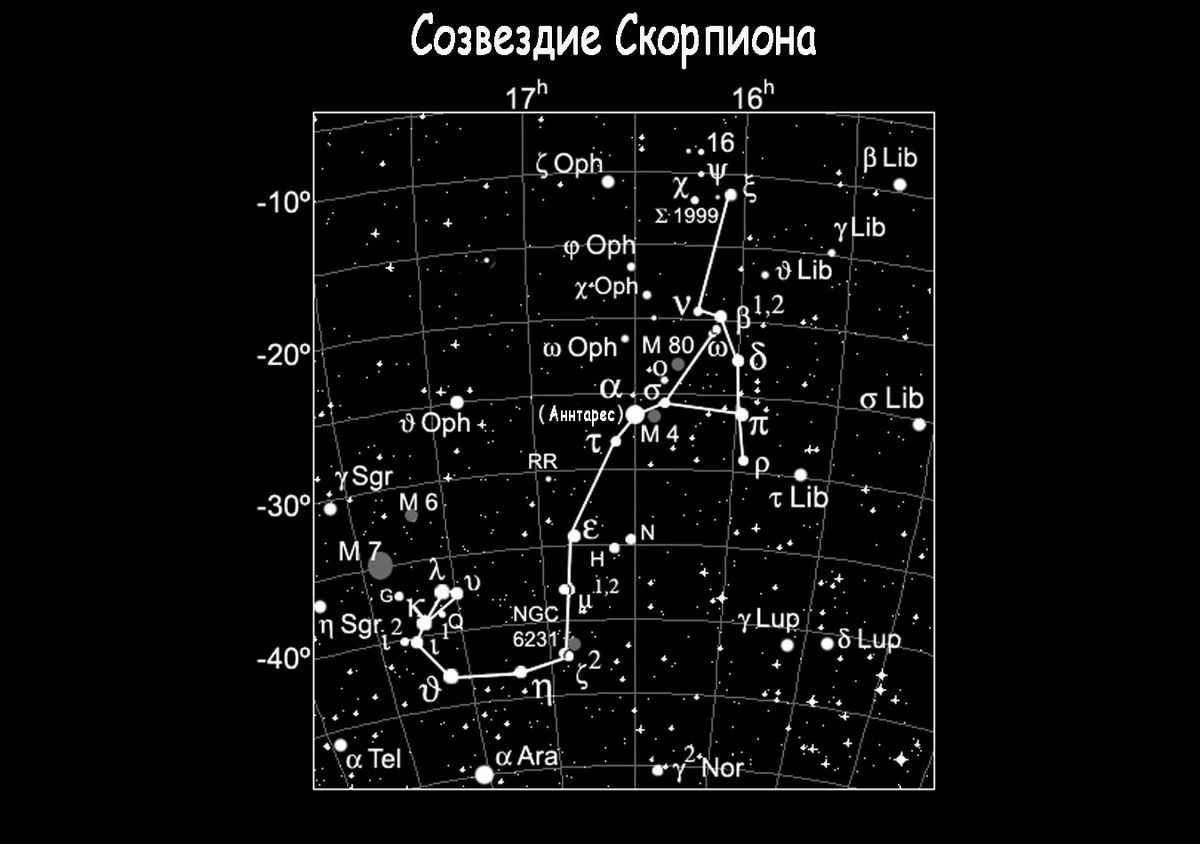
Scorpius, also known as Scorpio, is a constellation that can be found entirely within the Milky Way. From November 23 to November 29, the Sun passes through this constellation, making it the shortest ruling period for any zodiacal constellation. Once the Sun departs from Scorpio, it moves into the neighboring constellation of Serpens, which is not part of the zodiac. As a result, an additional 20 days are included in Scorpio’s ruling time.
Exploring the heavens

A captured image of the star pattern taken from the planetarium software
Because of its position in the Southern hemisphere, the Scorpius constellation does not appear very high in the sky. At moderate latitudes, the primary star of the constellation, called Antares, can be seen near its highest point above the horizon. During this period, it is precisely situated in the south. The simplest way to locate Scorpius is by using the Virgo constellation as a guide, heading southeast and passing through Libra.
Fascinating items
The Scorpio constellation boasts a multitude of luminous stars that, when connected, form a striking pattern resembling a scorpion. The most brilliant star within the constellation is Antares. Following closely are the noteworthy stars known as Aqrab and Shaula. Additionally, Scorpius is home to a neutron star named Scorpius X-1. Even a modest telescope can unveil star systems within this constellation.
Stellar Bodies
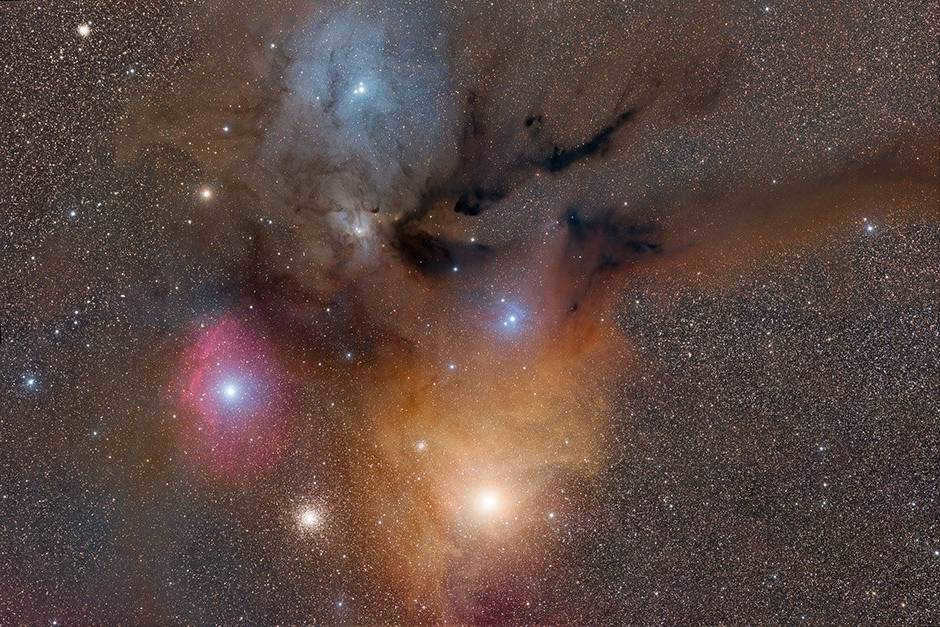
Image of the Nebula near Antares and Rho of the Serpentarium
Antares is the most luminous star situated in the Scorpius constellation. Its name is derived from the Greek, meaning “rival of Ares.” Antares is situated at the center of Scorpius and is a red supergiant star, which exhibits variability in its brightness (ranging from 0.86 to 1.05 magnitudes). Visually, it bears a striking resemblance to the planet Mars (Ares is the Greek name for Mars). Antares has a diameter approximately 700 times larger than that of our Sun and shines with a brightness that is 9000 times greater than the Sun. It is a binary star system, and upon closer observation with a telescope, one can see a dominant blood red giant paired with a less luminous companion that emits a bluish light. In contrast to its massive companion, the smaller star appears green.
The M4 star cluster can be found near Antares and Rho Serpentes.
Aqrab – is a celestial body that was observed by the ancient Greeks and referred to as Rafias. It is a binary system with two components, one with a brightness of 2.6 star magnitudes and the other with a brightness of 4.9 star magnitudes.
Shaula – A star located at the tip of the constellation’s tail. Its name comes from Arabic and directly translates to “sting”, which accurately describes its position.
Scorpius X-1, the neutron star, has a hot white companion and emits powerful discrete X-ray radiation.
The New Scorpius star system consists of seven prominent celestial objects.
Additional items
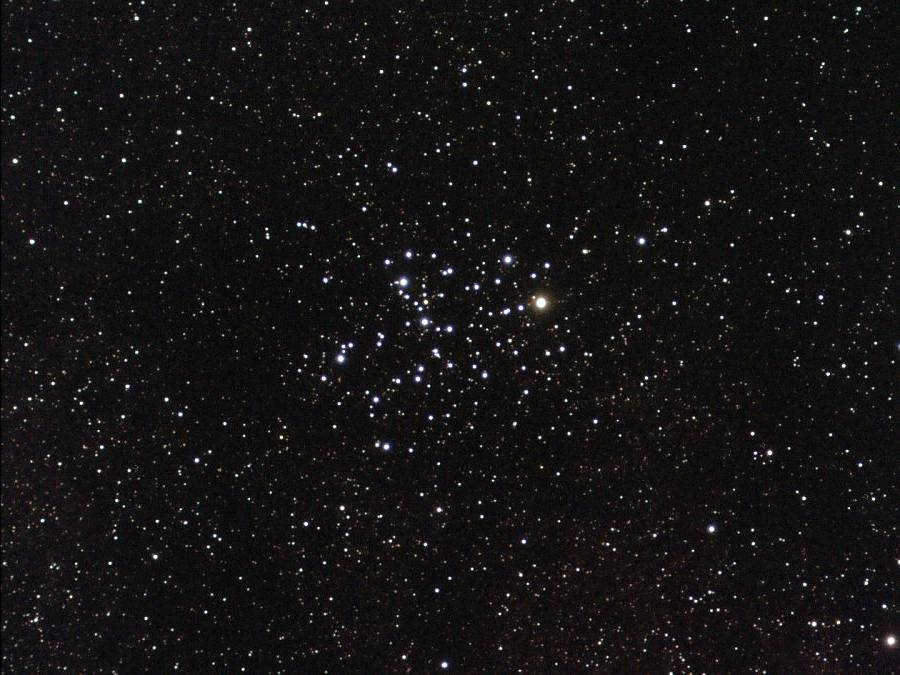
Photograph of the Butterfly Cluster, M6
In the constellation, researchers have recently identified a potential black hole. There are various groupings of luminous stars, such as M6, M7, and NGC 6231, as well as globular clusters named M4 and M80, which can be easily observed using binoculars.
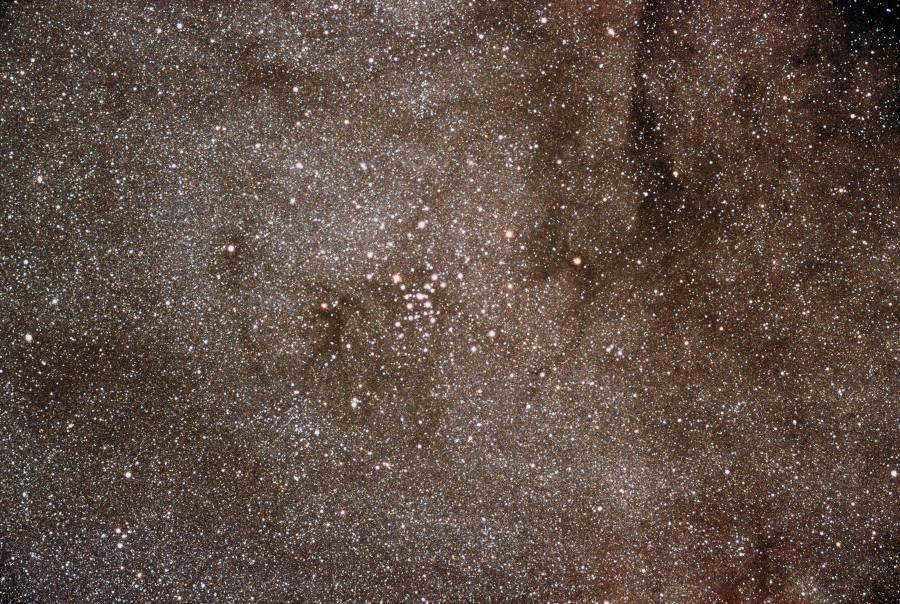
Scattered Cluster, M7 Photo
Asterisms
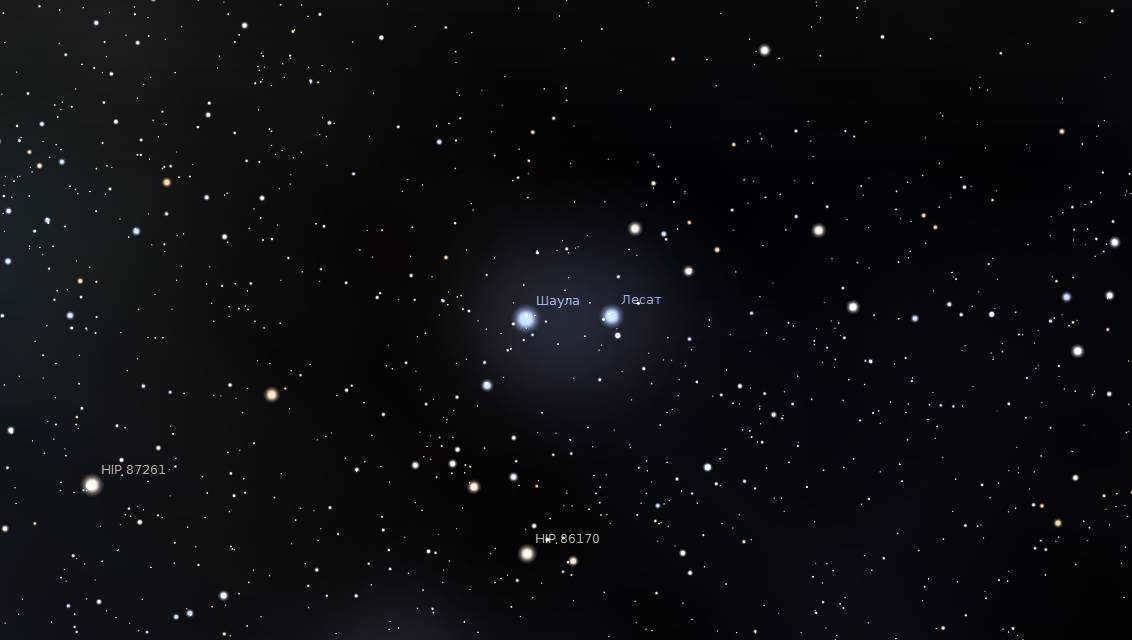

Photo of the asterism known as Cat’s Eyes
Scorpion’s Tail is an asterism found within the constellation. It typically starts from Antares (α) and includes the stars τ, ε, μ, ζ, η, θ, ι, κ, λ, and ν.
At the very end of the tail, there is an asterism called Cat’s Eyes, which consists of two stars.
The Background
